News
Dear Colleagues
One only needs to think of the huge cases of lying and dishonesty within large industrial companies such as Volkswagen (car emissions fraud), Enron and Tyco (both accounting fraud), and the increasingly cynical commentary about these cases from a weary public to wonder whether this is a fast growing trend. I often wonder whether it is simply about people regarding it as a playful attempt at gaming the system rather than believing these cases are fraudulent.
However, there is no doubt that these cases above are simply representative of blatant dishonesty and lying. Ron Carucci has done extensive research on the issue and believes that there are a number of simple reasons why dishonesty and lying penetrates an organisation – no matter whether you are running a tiny plumbing company with three employees or a billion dollar industrial enterprise selling electrical switchgear throughout the world with tens of thousands of employees.

Ron’s research revealed that these reasons are easily within the control of the organisation and can save you from huge organisational value destruction. Even if an organisation isn’t actively pursued under the law for lying, thieving and corruption – there is no doubt that the resultant reputational damage is enough to destroy value. I saw this happen only this week; when a huge organisation was investigated for corruption and dishonesty in gaining governmental contracts – within weeks of the news being out – even though they were hugely profitable – they have been forced into liquidation as their banks being nervous about being tarred with the same brush – have withdrawn all banking facilities.
A few suggestions from the research (and my take on the issue):
A lack of Strategic Clarity. Where there is a mismatch between the organisation’s stated mission, vision and values and what happens on the shop floor, there is a high likelihood of dishonesty. When employees are required to do things which are in stark contradiction to what the overall positive vision requires - such as cutting quality corners and compromising safety in an attempt to lift production, things start going badly wrong.
Badly Designed Accountability Systems. Where employees are held to unfair targets which have no hope of ever being met. They then start to invent reasons why these targets are actually being met and being pushed to be dishonest. I think of the classical case with defective project management where an engineer is held to certain unreasonable time and cost targets where there is not a hope in hell of these being met – in an attempt to keep her job and her bosses happy, she will tweak the figures to show that she is still on target. Recently down the road from our offices, a huge business building power stations and mineral processing plants went belly-up because (too late) they discovered huge company-destroying losses in the construction costings as a result of dishonest (so-called ‘optimistic’) reporting.
Transparency in governance and management. Where open meetings are avoided and the truth forced underground about the real day-to-day operations of the company resulting in incorrect information spreading by rumour, the scene is set for the blocked artery syndrome of limited information flowing through the organisation and then being used to make poor decisions. Sure – giving bad news to management about problems on a project is hugely painful but the way the problems are dealt with is what predicates a successful company.
Development of Silos. I never cease to be amazed that even tiny companies rapidly develop a silo mentality where departments run their own race without working closely with their peers in other departments. This results in a dysfunctional company with dishonesty breeding as a result.
Conclusion
I can categorically assure you that there is no organisation on this planet which is 100% squeaky clean on these four measures above. However, working hard on an ongoing basis to address these points above will make a dramatic improvement to your operations, employee and customer satisfaction and indeed, your bottom line. And enable you to withstand the inevitable economic storms we all are buffeted with from time to time.
Warren Buffet says it all: "In looking for people to hire, you look for three qualities: integrity, intelligence, and energy. And, if they don't have the first, the other two will kill you."
Thanks to Ron Carucci and the Harvard Business Review for a fascinating take on dishonesty in organisations.
Yours in engineering learning
Steve
It seems engineering terms are becoming buzzwords within the industry.
For example, words like The Fourth Industrial Revolution, the Internet of Things, Artificial Intelligence, the Blockchain — and more — are all misused in quickly rattled off articles and political speeches.
In fact, it seems that the people peddling these terms are not actually aware of their meaning. It is easy to refer to the Fourth Industrial Revolution without giving credence to the technologies that are bringing the revolution about.

The risk is that engineers entering the industry might be unsure of which type of engineering to pursue when buzzwords are being thrown from all angles. When it comes to terms like the Internet of Things and Artificial Intelligence...it’s a delicate balance.
IoT vs. AI: Which way forward?
The Internet of Things refers to connecting machines together and harvesting the data that they generate, whereas Artificial Intelligence is about engineering an intelligence comparable to human intelligence.
The overarching difference is who interprets and essentially makes sense of the data. Thus, AI can be plugged in at the technological level that can make sense of the data generated by Internet of Things technologies. As a result, in some instances, some systems can be interconnected in an Internet of Things network and have an artificially intelligent software making sense of the data it is receiving.
However, a new report by EE Times has taken a look at the revenue expectations for the Worldwide Deep Learning Chipset industry. The report seems to indicate that ‘five-sixths of the growth in semiconductors' will be in AI technologies alone by the year 2025.
The Internet of Things, merely a technological shift where an interconnected network of things (or computers) talk to each other, may be on the back foot of the semiconductor industry because AI setups are usurping that sector.
Analyzing data with deep-learning algorithms seems more of a technical task than connecting things together and needs other AI technology altogether. CPUs, GPUs, and the like are unable to process the data networks generate as effectively as algorithms can, and so those technologies fitted with the correct semiconductors have reached the market and are ready to do the job.
So what kind of semiconductors can prospective engineers expect to see in the industry? Application-specific integrated circuits, application-specific standard products, systems on a chip, and accelerators for artificial intelligence. Each chip being algorithm specific in its own right.
Those algorithm-specific and application-specific semiconductors are tailor-made for, for example, autonomous vehicles, Wall Street, farming technology, weather forecasting, etcetera.
The Engineering Institute of Technology is delivering a Professional Certificate of Competency in Machine Learning and Artificial Intelligence. The course will begin on 13 May 2019. The course is presented by industry lecturers with more than 15 years of experience in the development and management of artificial intelligence. The course teaches students incredible problem-solving skills in the machine learning world and trains them in building algorithms to automate processes regardless of the industry.
Enquire about the course today and start clearing up the basics, and start your journey on focusing what the engineering industries that exist require right now.
Works Cited
Shuler, Kurt. “IoT Was Interesting, But Follow the Money to AI Chips.” EETimes, EE Times, 20 Feb. 2019, www.eetimes.com/author.asp?section_id=36&doc_id=1334342.
Sync, CRM. “The Future of IOT Is AI.” TechUK - Representing the Tech Industry in the UK, TechUK, www.techuk.org/insights/opinions/item/13827-the-future-of-iot-is-ai.
A decade of corruption, mismanagement, sabotage, poor power station designs, and a recent natural disaster has led to the implementation of more rolling blackouts in South Africa's energy sector.
At the end of 2018, Eskom admitted that they were unsure when the next break in transmission was going to be. Initially, they wanted to ensure that South Africans would not be in the dark during their Christmases.
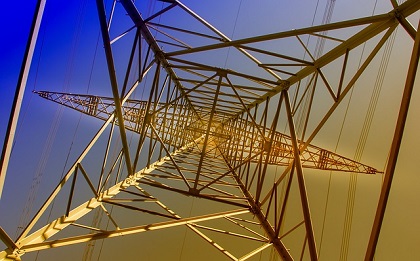
During that time, an intensive investigation into the problems Eskom was experiencing was launched. They were looking for good, honest people with the right technical skills. They did not want Stage 2 load-shedding. However, three months later, the country would see an unprecedented Stage 4 load-shedding. For each customer, for an entire week, their electricity would be cut off twelve times, for two-and-a-half hours each time.
Eskom has 47,000 MW of installed capacity that is serving all South Africans. The current demand of South Africans at a theoretical peak during the summertime is 29,000MW. The demand Eskom is able to reach (with all of their problems considered) is about 26,000MW.
Eskom indicated that a contributing factor to their woes was the age of their plants was a massive problem, too. Monetary investment into the maintenance of the plants in the last few years, but they allege that the repairs were not done adequately.
Eskom is hoping to find the relevant skilled individuals who can quickly meet the requirements of the state-owned enterprise. They need the right people to take a look at their problems and suggest implementable solutions.
So, how can freshly qualified engineers or even students help solve the problem?
Managers, students, professionals
It is imperative that all professionals and future professionals in the electrical engineering industry in South Africa keep upskilling within the industry. They never know when a state-owned electricity utility could be knocking on their door and asking them to save the day.
Public Enterprises Minister Pravin Gordhan at a press conference on the 6th of December 2018 said:
“We are going to find independent experts, a few of them, so that they could take an arm lengths view of these plans and the nature of the problems, and the nature of the solutions we have prescribed.”
Gordhan said in December that Eskom was in crisis mode. He said they would look within the company to find capable individuals to become power station managers to ensure power stations ran at an optimal level with zero incompetence.
After looking inward, they began looking outward as well. At the beginning of 2019, Eskom began asking top engineers from Italian energy company Enel to assist with Eskom's maintenance issues.
Chairperson on the board of Eskom, Jabu Mabuza said:
“This cannot be solved by Eskom alone. These are problems that we have all caused as South Africans. Either through our people, or through our government, but these are problems that we have caused. So, there is a role that we all have to play - shareholders, providers of capital, staff, customers - this is a choice of pain we need to take going forward, to try and put us back into a sustainable way.”
The company has approached the Auditor-General and the National Treasury to secure a special procurement dispensation to pay professionals for their assistance with their services and expertise. They are hoping that these companies and the ultimately skilled individuals might help keep the lights on.
Gordhan also mentioned to media recently that they were head-hunting at universities for students who could take a look at the power stations and provide feedback and suggestions for how Eskom might better run them.
What is also clear is that the stage is set for more Independent Power Producers to flood into the energy industry in South Africa. There is also a US $310 million government fund ready to invest into small scale embedded generation (SSEG) projects which will also create new jobs for highly technically qualified engineering professionals and workers, but the fund has been held back because of regulatory constraints.
There are also regulations preventing individual municipalities in the country from generating their own electricity. The state-owned utility has taken that entire job on its own shoulders. Opening up the regulations allows for municipalities to hire professionals to build a brand new, unique grid and would lead to far more citizens getting access to electricity - perhaps some for the first time.
The result could see engineering professionals getting jobs in general and renewable energy projects the country desperately needs to keep the lights on and to circumnavigate load shedding on already aged infrastructure. It could take many homes, businesses, warehouses, factories, mines, and farms off of the national grid and reallocate the electricity for areas that are in desperate need of it.
As a result, South Africa’s electricity problems also present the country with opportunities. As the country draws closer to their next election, electricity (and the lack of it) will be something the voters might have at the back of their minds as they cast their vote.
Works Cited
6 Quick Fixes That Can Save South Africa from More Load Shedding, www.businessinsider.co.za/6-quick-fixes-that-can-save-south-africa-from-more-load-shedding-2019-3.
“Eskom, Gordhan Briefing on Operation Issues.” YouTube, 6 Dec. 2018, youtu.be/3KXg_o5Zth0.
It was close to being the first giant leap for womankind but is now a very public stumble for one of the world's leading space agencies.
NASA announced on Monday that the first all-female spacewalk in history would be cancelled due to a somewhat confounding mistake from the same agency that sent human beings to the moon; they didn’t have a spacesuit in the right size.
Anne McClain and Christina Koch were scheduled to walk together in space on Friday to change the batteries on some of the International Space Station’s (ISS) solar panels. What would have been a triumphant end to Women’s History Month came to an abrupt halt after realization that both astronauts would require medium-size torso components, in which the ISS only has one.

The mission will still go underway; however male astronaut Nick Hague will replace McClain.
"... after consulting with McClain and Hague following the first spacewalk, mission managers decided to adjust the assignments, due in part to spacesuit availability on the station," a NASA statement said.
"McClain learned during her first spacewalk that a medium-size hard upper torso -- essentially the shirt of the spacesuit -- fits her best. Because only one medium-size torso can be made ready by Friday, March 29, Koch will wear it.”
There has been a strong online reaction to the news, shifting a harsh spotlight onto the unsuspecting agency.
Immediate responses were seen on all social media networks with many seeing the change as another frustrating strike against progress for women participating in space missions. NASA sent their first female astronaut on a mission over three decades ago.
The agency even saw a response from politician Hillary Clinton, whose solution was to tweet “Make another suit” and whilst it might look good online, making another suit is no easy task and has been a sensitive issue with NASA before.
A 2017 inspector general report highlighted the need for new spacesuits as the ISS currently only houses eleven suits, all designed over forty years ago. The startling number was also followed up by the report further stating that NASA is still “years away” from having a new space suit ready for future deep-space missions. The 20 million dollar price tag on each suit doesn’t help the cause either.
Whilst it is disappointing that this major milestone for women in space won’t be reached this week, it’s more an important topic of safety rather than sexism.
"This decision was based on my recommendation," McClain tweeted yesterday (March 27). "Leaders must make tough calls, and I am fortunate to work with a team who trusts my judgement.”
We must never accept a risk that can instead be mitigated. Safety of the crew and execution of the mission come first."
Students at the Durban University of Technology (DUT) and at the Technical Vocational Educational and Training (TVET) institutions in South Africa are facing a horror situation at the beginning of their academic year.
At DUT some of the students are responsible. Their protests have been followed by vigorous retaliation from private security and have resulted in the shutting down of the institutions.
Students at the Durban University of Technology (DUT) have protested at the living conditions in their accommodation and also at the shortage of it. On the 5th of February, one of the twenty-year old students was killed by a private security guard; this forced the protests into overdrive.

The students have charged the National Student Financial Aid Scheme (NSFAS) with conspiring with DUT to defraud funds. They believe The NSFAS allocates thousands of rands to the university, for its student accommodation, but then squeezes eight or nine of them into apartments designed realistically for three.
The students say they could find much better accommodation if they were given access to the money themselves.
The accommodation troubles go further: DUT has accommodation available for 13,000 students, but has a student population numbering 30,000.
To alleviate this DUT is reportedly paying the landlords of apartments, in the surrounding town, to evict tenants. According to investigative journalism program, Carte Blanche, tenants who have lived in those apartments for decades are being given eviction notices to make way for the incoming students. The landlords reportedly agree to marginally renovate the apartments and then accommodate 8 students in a single apartment.
Sadly, apart from the student uprising, crime is also on the rise around the DUT campus. Women in particular say they do not feel safe.
Five of DUT’s campuses have suspended their academic programs due to a stalemate in conversation between the management and the student representative council headed up by the Economic Freedom Fighters (EFF).
To make matters worse for students in South Africa, in the more northern city of Pretoria, members of the National Education, Health and Allied Workers’ Union (Nehawu) have gone on strike citing ‘horrible working conditions’. They also made mention of low salaries and useless pension benefits. The strike meant that lecturers linked with the unions would effectively ‘down tools’ and not teach students in the TVET sector.
Workers from 50 TVET colleges were involved in the strike. Nehawu vowed to shut down all TVET and CET colleges around the country.
International standard
South Africa simply seems unable to sustain the TVET colleges they have. Constant shutdowns and general maladministration is stifling the academic progress of prospective technologists and future engineers.
Student leadership of the African National Congress believes that TVET college qualifications should be recognized as equal to university degrees. And yet at TVET colleges lecturers are striking and rebuffing professional development which does not bode well for the system.
Badly resourced and with a dwindling pool of skilled lecturers the TVET colleges are not only hindering their students, but also the country; South Africa and the South African economy desperately need able, vocationally trained graduates.
There are alternatives, of course, and one of them is the Engineering Institute of Technology (EIT). South African students can acquire Australian qualifications via a live and interactive platform of learning, from home.
EIT offers Bachelor of Science degrees (in 4 engineering fields), (and Master degrees) and a host of Advanced Diplomas. Away from the potentially disruptive elements of a campus and the scramble for accommodation students can attain a high quality qualification, accredited by the Australian Government, from the safety and comfort of their own homes.
EIT’s mission is to prepare students for work in the fields of engineering and technology. The technology used in the online learning platform enables learners to practice the theory they learn and they receive industry-driven content from an international team of engineering experts, who teach live online. There are also supported by dedicated Learning Support Officers throughout their studies.
The schools of engineering at EIT include:
- Data Communications and Industrial IT
- Industrial Automation, Instrumentation and Process Control
- Electrical Engineering
- Mechanical Engineering
- Civil Engineering
- Electronic Engineering
- Engineering Management
Visit the website and enquire today!
Works Cited
“Carte Blanche.” YouTube, YouTube, www.youtube.com/channel/UCW67mIQxNQ3G2AHffz8Bvvw/videos.
Ncobela, Stanley. “TVET Colleges Need Serious Attention from Government.” SowetanLIVE, Sunday World, www.sowetanlive.co.za/opinion/columnists/2019-02-14-tvet-colleges-need-serious-attention-from-government/.
Cameron Russell Bourne is an engineering and technical specialist with a background in Energy, Oil & Gas and Heavy Marine industries. He is currently employed at Synergy, a large energy supplier in Western Australia as a Mechanical Technician.
His day-to-day responsibilities at Synergy see him presiding over a plethora of systems. He says:
“I perform a wide range of tasks including inspection; fault diagnosis, investigations, condition monitoring, reliability testing, balancing, commissioning, and providing analytic reporting services for plants & systems used in large thermal power-generation processes. These systems include boiler, turbine, auxiliary plants, pumps, high-grade steam, pressure equipment, mobile plants, and fire, raw water and reverse osmosis systems.”

Cameron enrolled in and graduated through the Advanced Diploma of Mechanical Engineering Technologies with the Engineering Institute of Technology. He was a runner-up for the Graduate of the Year 2018, as announced at EIT’s Australian graduation.
Not only does he assist in the Oil & Gas industry, but he is also dedicated to the Emergency Response industry, and is a firefighting and emergency operations specialist too. How did Cameron manage to juggle all of these industries and manage to study at the same time? He chalks it up to EIT’s online delivery. He says:
“The online delivery of this course via the webinars and web page correspondence was the only way possible for me to achieve this qualification without having to give up my country lifestyle and regional location — this education model suited me very well.”
But, it wasn’t all smooth sailing. Cameron found that he had to break some old habits to get through the course successfully — going from never having studied online to studying entirely online was a new experience for him. However, something that motivated him throughout the course was the character and approachability of the lecturers.
“They have great background knowledge and in most cases are up to date with the latest technologies relating to the content of any particular module. They were always ready for further discussion post webinars and responded to any email queries within a reasonable time frame.”
Applying what’s been learned
Cameron has leveled up from engineering tradesman to a technician role in his workplace, since pursuing his qualifications with EIT. He has no doubts that the high level of success he was able to achieve in his workplace is because of his professional development. He said:
“In the role that I currently work in, I am fortunate enough to be able to use all of the skills that I have learned over the past 18 months and my development as a Mechanical Technician has gone from strength to strength.”
Now, he says, his time management skills are far better than they used to be. He says he is also more prepared for working with multidisciplinary teams in his workplace and feels more confident that he can get things done. He concludes:
“Having a deeper understanding of how and why things work, means I have developed a greater knowledge of how to manage their associated risks. I have found that my skill set as an emergency services officer has also been enhanced, which has been beneficial not only for my employer but also for the community in which I live.”
Remote invigilation - otherwise known as online proctoring - might just be the critical factor when measuring the success of online higher education. Online education without digital supervision would naturally be a sticking point for education accreditation boards across the globe. It is not surprising, therefore, that online proctoring solutions are growing.
The Engineering Institute of Technology (EIT) have been hard at work developing the IRIS Invigilation (IRIS). It is a cloud-based platform which utilizes machine learning to monitor students during online examination and tests.

This software program helps provide educators assurance of assessment integrity during online and remote assessment. IRIS records audio, video, and computer screen activity for the duration of a test/exam. It analyses this information using machine learning and automatically flags potential academic dishonesty displaying the data in an easy to use reporting dashboard.
Screenshots are taken at intervals and sent to the invigilating program, this is to double-check what students are seeing on their screens. If anything other than what should be there is detected, the program flags this as suspicious.
IRIS is cloud-based – this means that no heavy software is required on a student’s device; in fact it is so lightweight it can run on a web browser. Furthermore, because the machine learning is largely responsible for identifying potential cheaters, the requirement for staff involvement drops off significantly.
A big benefit to the system is the learning analytics that provide incredibly detailed insight into educational trends and patterns based on real student data. Curtin University told IT News that they hope to see the invention make its way to the ‘rest of Australia's 700 Vocational Education and Training providers’.
A new chapter in online education
Perfecting online proctoring is of utmost importance considering the global online education market is projected to reach a total market size of US$286.62 billion by 2023, as reported by Research and Markets. This means more and more students are opting for online study - but invigilating those students remotely, during examinations, is a tall order. An excerpt of the report reads:
“Platforms that facilitate learning through gaming are gaining popularity, improvements in IT security and implementation of cloud based solutions has increased the adoption rate of online education system as now, people can enjoy a smooth learning experience on safe online platforms. Advancements in the field of artificial intelligence are expected to further boost the growth rate of the online education market.”
Although critical in the virtual classroom, online invigilation is likely to become a useful tool in the physical classroom too – as part of an on-campus, hybrid learning invigilation system. The problems with on-campus invigilation are prompting the change; these include the need for a battalion of human invigilators and the greater margin for error (whereas an automated system can monitor students individually).
In South Africa for instance, even at the Further Education and Training phase (Grades 10 to 12), the Independent Examination Board has instructed schools to install invigilation cameras in any venue where examinations take place.
It is clear that invigilation technologies are becoming more vital to education institutions around the world, but especially to legitimize online education once and for all.
Works Cited
Johnston, Matt. “Benchmark Awards 2019 Finalists: Curtin Uni Remote Exam Invigilation.” ITnews, 4 Feb. 2019, www.itnews.com.au/news/benchmark-awards-2019-finalists-curtin-uni-remote-exam-invigilation-518736.
ltd, Research and Markets. “Global Online Education Market - Forecasts from 2018 to 2023.” Research and Markets - Market Research Reports - Welcome, www.researchandmarkets.com/research/nzxrnp/global_online?w=4.
Twenty-five percent of engineering graduates are jobless in India, according to a study published by the All India Professionals Congress. Whereas a study published 1,618 miles away, in the United Arab Emirates, indicates that there are not enough graduates to go around. This is in a region where engineers are highly sought after.
The study in the UAE was named ‘Majors in Demand’ and was conducted by the Ministry of Education. The study took a look at over 13,000 graduates from government and higher education institutions who graduated in 2017.
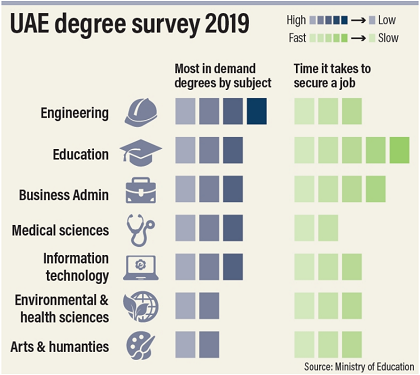
They found that civil engineers were most in demand, but believe that their findings would be a useful guide to undergraduates generally.
The Minister of State for Higher Education and Advanced Skills in the UAE told state media:
“This study is an ideal forecasting tool for students”
The study in India paints a grimmer picture than that painted by the UAE. The country seems to have a glut of engineering graduates with not enough jobs available for them.
The report out of India comes from the All India Professionals Congress. They canvassed 2,600 engineering graduates, finding that 25 percent of the graduates were unable to find employment.
All India Professionals Congress secretary Sudheer M told media:
“It is the need of the hour that we consider education a serious factor in the country’s progress. This prompted me to conduct a study of engineering education to start with.”
The Times of India goes on to report on which graduates are having more luck: mechanical engineers are most likely to be employed, but that civil engineering graduates are also being hired.
Of the students canvassed, however, 80 percent indicated that they felt a lack of connection to the engineering industries in the country.
This connection to industry is something the Engineering Institute of Technology (EIT) feels is critical to a graduate’s success. And to this end the college works hard to contextualize all theory, add real practice into the engineering bachelor and master degrees and expose students to the relevant industries during their studies.
EIT also ensures that their industry-driven content is presented by experienced engineers from around the world. The online students interact with these experts in real time and the students on campus in Australia receive a combination of face-to-face teaching and globally-based lecturers streaming into their classrooms. EIT believes that graduates who are immersed in real engineering, throughout their studies, are more likely to find the jobs they dream of.
Works Cited
NewIndianXpress. “25 Per Cent Engineering Graduates Are Jobless, Says Study.” The New Indian Express, The New Indian Express, www.newindianexpress.com/states/kerala/2019/feb/03/25-per-cent-engineering-graduates-are-jobless-says-study-1933544.html.
Nowais, Shireena Al. “Engineering Graduates Most in Demand in UAE.” The National, The National, 9 Jan. 2019, www.thenational.ae/uae/education/engineering-graduates-most-in-demand-in-uae-1.811254.
TOI-Online. “Which Branches of Engineering Has the Highest Demand? - Times of India.” The Times of India, Business, 16 Jan. 2019, timesofindia.indiatimes.com/home/education/news/which-branches-of-engineering-has-the-highest-demand-bu/articleshow/67555535.cms.
Conflict and war are commonplace around the world and civilians are inevitably trapped in the midst of them. It is gratifying to report that engineering skill, in conjunction with technology, are working to alleviate some of the fall-out for the people caught up in these situations.
This doughty combination of technology and skill is making relief efforts more manageable: getting food, water, and medicine to those regions effected by war. It is also proving remarkably effective in remote areas.
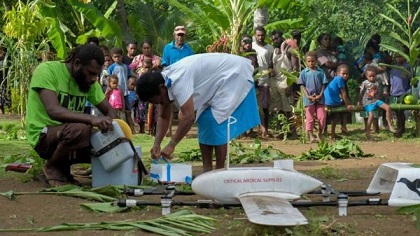
Australian company, Swoop Aero, is using drones specifically built for the betterment of healthcare. The company has been founded for the purpose of ‘redefining healthcare with airborne mobility’.
The company operates an on demand, high speed, autonomous airborne logistics network. And they have proven their usefulness on the Pacific island of Erromango, in Vanuatu.
ABC News was with the Australian company while they delivered vaccines to the island; an island notorious for low vaccination rates for children.
Separately the people of Erromango have been suffering with hepatitis and tuberculosis; vaccines for these maladies have also been successfully deployed by Swoop Aero.
UNICEF comments that Vanuatu’s ‘extreme remoteness’ makes delivery of vaccines, via traditional methods, very difficult. The nation is in fact an archipelago - made up of roughly 80 islands that stretch over 1,300 kilometers.
The United Nations International Children’s Emergency Fund (UNICEF) chartered the drone flights from Swoop Aero which are perfectly engineered for autonomous vaccine delivery.
On the company’s website Swoop Aero asserts that the drones can navigate the most hard-to-reach areas of the world. They write:
“Inhospitable terrain, unpredictable waterways, mountain ranges, poor infrastructure, traffic congestion, and long distances limit the capabilities of ground transport.”
The drones can travel at 100 kilometers per hour and are powered by batteries.
Unexpected variables
Nurses sometimes hike to reach the villages with the medicines they think the children and adults require. The villagers, however, often move from place to place, making it difficult to estimate the needs of each community. The drones proffer a solution because of their ease of mobility; they are more ably meeting the demands of the villages.
The price of drones has dropped considerably too, despite improvements to the technologies powering them. This drop in cost is making their use more viable in rural and remote villages.
Eric Peck, co-founder of Swoop Aero, told ABC News:
“It’s something that has been around for quite a while now, but we’re at this inflection point where for the first time we are seeing the cost of technology get down to a point where it’s economically efficient to use it.”
The Australian company is officially trialing the drones in Vanuatu and will measure the success of the project on completion. The system appears to be working with the backing of the Vanuatu government, UNICEF and the Australian government.
This is another example of how engineering can shape the world’s landscape for the betterment of humankind.
Works Cited
Dziedzic, Stephen. “A Two-Day Walk for Vaccines Is Now Just 20 Minutes Away with Drone Delivery in Remote Vanuatu.” ABC News, Australian Broadcasting Corporation, 18 Jan. 2019, www.abc.net.au/news/2019-01-19/using-drones-to-deliver-crucial-vaccines-to-remote-vanuatu/10728350.
Peck, Eric. “Vanuatu Uses Drones to Deliver Vaccines to Remote Island: BBC.com.” Swoop Aero, swoop.aero/swoop.aero/vanuatu-uses-drones-to-deliver-vaccines-to-remote-island-bbc-com/.
Ian Shivraj Doolun is originally from the Indian Ocean island of Mauritius. He completed his Bachelor of Engineering in Mechatronics with first class honors at Monash University. Upon obtaining his Bachelor of Engineering, he got offered a job at one of the best companies in automation and process control in Mauritius, where he worked for two and a half years as an Industrial Control Programmer.
Ian wanted to develop his career further and gain the cutting-edge automation knowledge needed as the Fourth Industrial Revolution continues to transform the engineering world. He decided to enroll in the Engineering Institute of Technology's Masters of Engineering (Industrial Automation). He reflected:
“I was surrounded by intelligent minds, and as a beginner I had to catch up quickly to integrate into the team and be able to provide efficient solutions. Doing the Masters course gave me a competitive advantage over my peers, both in terms of knowledge and chances of promotion.”

Ian then set his sights on Australia. Settling in Sydney, he is now working as an Automated Guided Vehicle (AGV) Project Engineer.
“The contents of the course aligned with my job. Some of the key modules that had a positive impact on my work were Programmable Logic Controllers; SCADA and Distributed Control Systems, and Industrial Process Control among others. I was also better at communicating my ideas, both technically and professionally. The course really stimulated my thinking process and enabled me to conduct my job more efficiently and effectively.”
Ian worked his way through the course so masterfully we are proud to recognize him as one of the finalists for EIT’s Graduate of the Year Award 2018. Ian did, however, learn the hard way in terms of simultaneously balancing work and his studies. But, eventually, a silver lining manifested. He said:
“The biggest challenge, at first, was the work-study balance in terms of time and dedication, but after the first couple of semesters, I got used to it. The assignments were also very challenging in some cases, but this allowed me to be more independent and enhance my research skills. The master’s thesis was also very strict in terms of schedule.”
Ian said through doing the course, he better understood industrial concepts and implementation strategies in the automation world. He concluded:
“I definitely applied what I learned to my work. My output at work improved tremendously.”
He is also about to take his Certified Associate in Project Management exam at the Project Management Institute, to further qualify him in his field. He said:
“I strongly believe that my strength resides in project management since I have very strong people and communication skills. However, I am always keen to enhance my knowledge of automation and other innovative topics.”
South Africa is a country with 27% of its population without work. Spirits have not been high for at least a decade; a struggling economy has been limping around entrenched and widespread governmental corruption. Thanks to a recent discovery, however, followed by an announcement by integrated oil and gas company Total, the country has perked up a little. Total said in a statement:
“We have made a significant gas condensate discovery on the Brulpadda prospects in the Outeniqua Basin, 175 kilometers off the southern coast of South Africa.”
The CEO of Total, Patrick Pouyanne, told journalists that there “could be around one billion barrels of global resources, gas and condensate light oil”. The site, in deep waters 175km off of the country’s southern coast, is in the proximity of a town named Mossel Bay.

Kevin McLachlan, senior vice-president of exploration at Total told the Financial Times:
“With this discovery, Total has opened a new world-class gas and oil play and is well positioned to test several follow-on prospects on the same block.”
South Africa benefits greatly as well. The country has been relying on oil imports for its national needs - now it is right on the doorstep. Experts say the find could lead to a growth of South Africa’s economy to the tune of more than USD $73 billion - or R1 trillion.
With a rig to be set up just off the coastline the South African Oil and Gas Alliance will be focusing on how to develop the skills of workers and ensuring engineering professionals are prepared for the forthcoming projects.
The announcement of the discovery came just at the right time for President Cyril Ramaphosa’s State of the Nation Address. Ramaphosa hoped the speech would encourage investor confidence in the country. In the speech about Total’s discovery, he said:
“Last night I received a call from Minister Gwede Mantashe {Mineral Resources Minister}. He told me that the oil giant Total would be making a big announcement today about a new ‘world-class’ oil and gas discovery off the coast of South Africa. We are extremely encouraged by the report….. which some have described as a catalytic find. This could well be a game-changer for our country and will have significant consequences for our country’s energy security and the development of this industry. We congratulate Total and its various partners and wish them well in all their endeavours. Government will continue to develop legislation for the sector so that it is properly regulated for the interests of all concerned.”
Eye Witness News reported that PetroSA is also very happy with the announcement. Their gas-to-liquid plant is allegedly running lower than 50% of its design capacity. This is heartening for the labor market too with the likely growth in jobs, from rig to refinery.
The next step for Total is utilizing 3D seismic data measuring equipment, after which drilling can begin. The drilling alone will reportedly be the largest scale hydrocarbon exploration project in the world.
Works Cited
Keohane, David. “Total Strikes South African Oil and Gas Find.” Financial Times, Financial Times, 7 Feb. 2019, www.ft.com/content/07b7798c-2abc-11e9-a5ab-ff8ef2b976c7.
Lauren Isaacs. “SA Offshore Gas Find Could Yield 1 Billion Barrels, Says Total.” Eyewitness News, 7 Feb. 2019, ewn.co.za/2019/02/07/sa-offshore-gas-find-could-yield-1-billion-barrels-says-total.
It is never pleasant to focus on engineering industry shortcomings. However, when new aircraft fall out of the sky, with multiple fatalities the result, the ugly business of discovering the faults commences.
On Sunday, 10 March 2019, a Boeing 737 MAX 8 (flight ET302) belonging to Ethiopian Airlines crashed just six minutes after takeoff from Addis Ababa. It went down on its way to Nairobi, Kenya, crashing into a town known as Bishoftu. Of the 157 people onboard, there were no survivors.
This crash was eerily similar to the Indonesian Lion Air Flight 610 which went down over the Java Sea in October 2018. It was the fact that they were both Boeing 737 MAX models which resulted in the inevitable comparisons. Both aircraft were iterations of a new series touted as ‘technologically advanced’ and more efficient than planes that had come before.
Worryingly, in both crashes the aircraft were only months old – essentially brand new. The US Federal Aviation Administration (FAA) reports that th
“The unmatched reliability of the MAX means more 737 flights depart on time with fewer delays. And technological advanced plus powerful LEAP-1B engines are helping to redefine the future of efficient and environmentally friendly air travel.”
Upon hearing the news of the Ethiopian Airlines crash, Chinese, Singaporean, Indonesian, Australian, Mexican and Argentinian airlines temporarily grounded their 737 MAX planes almost immediately – a ban which has now become a global one. Consultations with Boeing’s engineers and technical experts has begun, as has an investigation into what caused the Ethiopian plane to crash.
The United Kingdom took a hardline stance on the 12th of March 2019, the Civil Aviation Authority confirmed that they would ban all 737 MAX aircraft and would not allow any to enter UK airspace.
The regulator said in a statement:
“We have, as a precautionary measure, issued instructions to stop any commercial passenger flights from any operator arriving, departing or overflying UK airspace.”
This caused chaos for passengers - with some flights being diverted or turned back midair!
American President Donald Trump also weighed in on the conversation about modern day aircraft. Two days after the Ethiopian Airlines crash he tweeted:
“Airplanes are becoming far too complex to fly. Pilots are no longer needed, but rather computer scientists from MIT. I see it all the time in many products. Always seeking to go one unnecessary step further, when often old and simpler is far better. Split second decisions are needed, and the complexity creates danger. All of this for great cost yet very little gain. I don’t know about you, but I don’t want Albert Einstein to be my pilot. I want great flying professionals that are allowed to easily and quickly take control of a plane!”
Over complicating the aircraft?
Experts are treating both the Lion Air and Ethiopian Airlines crashes as suspicious. The Indonesian flight going down 13 minutes after take-off and the Ethiopian one going down after just 6 minutes is alarming aviation analysts.
Boeing has announced that it will release software updates for the 737 Max jets by April. The work on the software tweaks started after the Lion Air disaster. This began after it was reported that the pilots in the Lion Air disaster had trouble with a new feature added to the Maneuvering Characteristics Augmentation System (MCAS). It is alleged that the pilots may have not had any control over the plane after the MCAS software kicked in.
The MCAS was implemented when they noted that the new engines Boeing had fitted to their 737 tended to push the aircrafts’ noses upwards. The MCAS sensors were designed to respond to the aircrafts’ upward nose tilt and trigger the software to push the plane into a semi-nosedive to prevent a stall. It is alleged that the software reacted when the planes were still climbing and pushed the two planes into nosedives which the pilots could not correct.
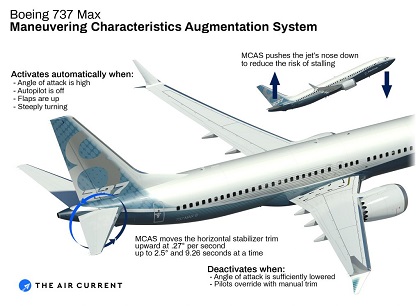
Boeing later said that the pilots in the Lion Air disaster should have taken the necessary steps to disable the software.
Boeing, after the Ethiopian Airlines crash, has had to defend their software, indicating that pilots do have the ability to override the software.
“It was put through flight testing as part of the certification process prior to the airplane entering service. MCAS does not control the airplane in normal flight; it improves the behavior of the airplane in a non-normal part of the operating envelope.”
Works Cited
Bazley, Tarek. “Control System under Scrutiny after Ethiopian Airlines Crash.” News | Al Jazeera, Al Jazeera, 11 Mar. 2019, www.aljazeera.com/news/2019/03/control-system-scrutiny-ethiopian-airlines-crash-190311094532350.html.
“Boeing.” Boeing: Philip M. Condit, 109380-Leslie Nichols, www.boeing.com/commercial/737max/.
Ostrower, Jon. “What Is the Boeing 737 Max Maneuvering Characteristics Augmentation System?” The Air Current, 23 Nov. 2018, theaircurrent.com/aviation-safety/what-is-the-boeing-737-max-maneuvering-characteristics-augmentation-system-mcas-jt610/.
Planet Labs has launched 146 satellites into space — officially it's the largest fleet of satellites in human history. The company began engineering the satellites with the intention of making each one roughly the size of a loaf of bread. They each weigh 12 pounds (5 kg).
The satellites are engineered by former NASA employees. Unlike when they were working for NASA, the turnaround time for the creation of these satellites is much shorter. They are as easy to design and build as a smartphone is.
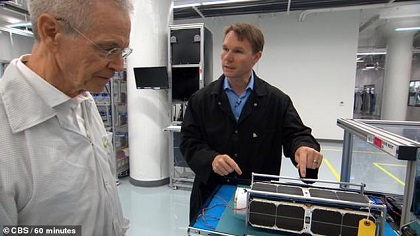
The satellites orbit the globe every 90 minutes taking photographs of the earth below. Co-founder of Planet Labs Dr. Will Marshall spoke to the news program, Sixty Minutes, about what can be seen on the images these satellites take of the earth. He said:
“We see rivers move, we see trees go down, we see vehicles move, we see road surfaces change and it gives you a perspective of the planet as a dynamic and evolving things that we need to take care of.”
They call the satellites doves and release them in flocks. 28 small satellites have recently been launched by astronauts aboard the International Space Station. The flocks spend their time snapping away, generating many images of the ever-changing earth, providing insights for those viewing them. The satellites generate 1.2 million photographs every 24 hours.
Planet Labs now allows companies, academics, farmers, and governments to access their data sets and images for research and — in the government's case — spying on other nations. They currently have 200 customers that utilize their images of the globe.
Planet Labs is now giving the U.S. government a much clearer picture of parts of the earth that they have never been able to investigate before.
Historically, dozens of engineers would have to be working on one satellite, but the company has revolutionized the industry. Making the satellites and more manageable has led to one engineer working on a dozen satellites. They have turned the tables on the satellite industry. The company has engineered around 300 satellites over the years, refining and learning from the process as they go along.
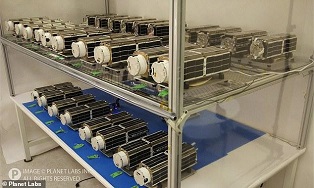
And sometimes, those lessons have been hard ones. On one of their launches, 26 satellites were destroyed in a launch accident when one of their rockets sending satellites up to the space station fell to the ground and exploded. The engineers immediately snapped back into action and quickly began work on meeting the demand for those lost satellites.
The founders of Planet have seen technology develop in record time. In their careers at NASA, it would take 5 to 10 years to get a satellite to space - now, it takes only a couple of weeks.
Works Cited
“Private Company Launches ‘Largest Fleet of Satellites in Human History’ to Photograph Earth.” CBS News, CBS Interactive, www.cbsnews.com/news/private-company-launches-largest-fleet-of-satellites-in-human-history-to-photograph-earth-60-minutes/.
Surely civil engineers who get to work on the world's largest and most up-and-coming vacation spots are the envy of their profession!
South Korean (and Spanish) civil engineers will be hard at work on the world’s largest man-made surf park in Turtle Island, South Korea very soon. Spanish wave pool company Wavegarden made the announcement in November 2018, reporting that they had signed a contract with Daewon Plus Construction — who happen to be South Korea's largest real estate and theme park developers.
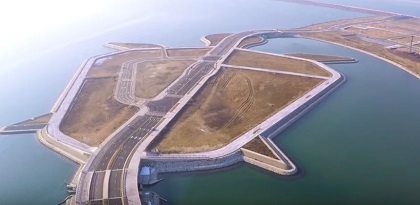
Turtle Island, a man-made island (literally in the shape of a turtle) is just an hour away from Seoul, the capital of South Korea. The image you are seeing above is the open land at Turtle Island where the hotels, Wavegarden park, and the marina will be constructed.
In their press statement, Wavegarden wrote:
“Constructed on land reclaimed from the ocean, Turtle Island is a new international waterfront destination, which will have different water and landside leisure facilities including hotels, convention centers, and marinas. The centerpiece of the 2.1 billion Euro (about $2.3 billion USD) avant-garde mixed-use development will be the Wavegarden Cove surfing lagoon.”
They intend to have the wave park open in 2020. The surf park will have a one-kilometer ‘beach front' that will provide lots of space for holiday goers. The Cove - an artificial wave generating pool - will reportedly create 1,000 waves per hour. Wavegarden says surfers of all ability levels are welcome. In their press release, they also talked about the novel engineering technologies that they work with:
“The state-of-the-art machinery can produce millions of waves per year and is designed to recover part of the energy used in the wave generation process to attain the lowest possible energy consumption. The innovative water treatment system, developed specifically for wave lagoons, will keep the water transparent and clean throughout the year. Its intelligent design uses the energy of the waves to acquire the highest level of energy efficiency available nowadays for large recreational water bodies."
Fernando Odriozola, Chief Commercial Officer at Wavegarden, told media:
“With consistent waves of different sizes and shapes, Turtle Island is going to be the new beach of Seoul and the place to surf for families, professional surfers, and everyone in between.”

And what better way to enjoy the world’s largest surf park than to surf the waves on the world’s most cutting edge carbon fiber surfboard? Alright, it’s a pretty regular surfboard with all things considered, but it is ‘engineered’ in collaboration with Tesla and Matt Biolos' Lost Surfboards. Elon Musk got the surfboard company to partner up with Tesla to create 200 boards and sell them for USD $1,500 each.
Wavegarden reports that they have signed a host of new contracts that will see Wavegarden technology making its way into five continents around the world. Two other wave pools are being built in Melbourne and Bristol.
To see what a Wavegarden experience looks like, see the video below:
Works Cited
SurferToday.com, Editor at. “Tesla Surfboard Accelerates down the Line.” SurferToday, SurferToday, www.surfertoday.com/surfing/tesla-surfboard-accelerates-down-the-line.
“Worlds Largest Surfing Lagoon: South Korea.” Carvemag.com, 7 Feb. 2019, www.carvemag.com/2019/02/worlds-largest-surfing-lagoon-south-korea/.
Toshiba Corp and General Electric have unveiled the robot that will again try to achieve what no robot has been able to accomplish before it; locating and removing the spent, melted nuclear fuel of the Fukushima Daiichi nuclear reactor number three.
The cleanup and decommissioning of the three nuclear reactors that fell victim to meltdowns after a powerful earthquake and subsequent tsunami in 2011 is ongoing. The cleanup will cost the equivalent of USD$190 billion.
The path to decommissioning began with locating the spent, melted nuclear fuel inside the reactors. No human can withstand the radiation levels present in the reactors. Consequently, radiation-resistant robots have been sent down to attempt to locate the fuel. But, all the robots that were entrusted to finish the job have all stopped short due to the large radioactivity present in the reactors.
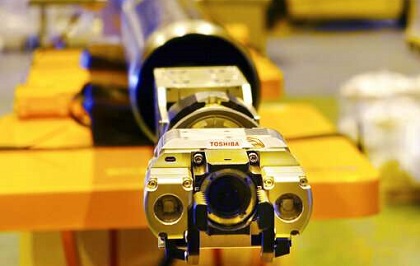
However, a probe with a camera attached to it successfully managed to get images of the melted fuel in Unit 2’s reactor last year. The other two reactors’ melted fuel is still unseen, but engineers are confident they have detected it and can find it easily.
Back in 2017, the cleanup crew sent a Toshiba robot named the Scorpion Robot down to the No. 2 Reactor. The radioactivity caused the robot to stop midway and disabled one of the wheels. There is still no indication of where the spent fuel exactly is.
Engineers have tried four-legged robots, stair-climbing robots, robots with wheels, robots that could swim through water, and more. They all seemed to be unable to complete the mission.
In with the new
The new robot by Toshiba Energy Systems & Solutions Corp and GE is a device engineered to traverse into the hard to reach places in the nuclear reactors. The robot will go down an 11-meter long pipe and will be in reach of the melted nuclear fuel in Unit 2.
The robots are fitted with tongs that will attempt to grip the melted fuel and extract it. It also has lights and electronic measurement equipment at the tip of the pipe that will do the relevant tests the engineers need to determine if the extraction is done safely and efficiently.
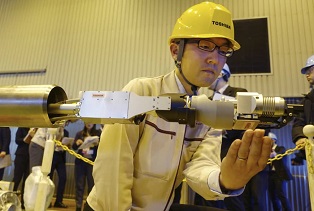
Jun Suzuki, a Toshiba ESS group manager for the project said:
"Until now we have only seen those deposits, and we need to know whether they will break off and can be picked up and taken out. Touching the deposits is important so we can make plans to sample the deposits, which is a next key step."
The issue is that there might not be anything of value to pick up with the robot’s tongs when the robot goes down into the reactor in February of this year. However, the engineers at Toshiba say if the robot is unable to lift anything out of the reactor, that will also be a key finding. The Fukushima Meltdown aftermath is an engineering conundrum of epic proportions, and it's not over yet. Perhaps the engineers may have just figured out how to get closer to ending it with their novel tong-robot. Even if it's by taking baby steps.
Works Cited
“Toshiba Unveils Robot to Probe Melted Fukushima Nuclear Fuel.” Phys.org - News and Articles on Science and Technology, Phys.org, phys.org/news/2019-01-toshiba-unveils-robot-probe-fukushima.html#jCp.
“Toshiba Unveils Robot with Tongs to Probe Melted Fukushima Nuclear Fuel.” The Japan Times, www.japantimes.co.jp/news/2019/01/29/national/science-health/toshiba-unveils-robot-tongs-probe-melted-fukushima-nuclear-fuel/#.XFCmWVwzZPY.
South Africa's energy utility is in dire straits. On the 11th of February 2019, the utility's engineers implemented Stage 4 load shedding on South Africa's main energy grid. Stage 4 load shedding indicated that the country was short 4,000MW of the peak capacity requirement of 27,000 MW due to what the utility called ‘continued pressure’ on the national grid.
The utility has 45,000 MW of energy capacity installed, but cannot meet the peak demand of 27,000MW. Experts say the current situation reeks of gross incompetence at the very top levels of management at Eskom.

The country has never experienced Stage 4 load shedding in its history but is well acquainted with Stage 2 which the country saw intermittently in 2018. The new stage meant that South Africans would see their lights turned off twelve times in the space of four days.
Eskom pointed to the fact that there are six generators not functioning correctly in the country. Moreover, the utility's mega power stations —Medupi and Kusile — reportedly have major design and technical flaws that are causing the stations to underperform. What is clear is plant breakdowns, a lack of plant maintenance, a shortage of trustworthy engineers, and poor management of the energy grid, in general, has led to an energy crisis in South Africa.
The impact of the power cuts reportedly costs the country R2.5 billion (USD $181 million) in business revenue every day the lights are off.
South African President Cyril Ramaphosa recently delivered a State of the Nation address wherein he declared that Eskom would be unbundled. It would be broken up from one large organization and divided into three organizations.
This seems to have rung the alarm bells of the National Union of Mineworkers, the National Union of Metalworkers, the South African Communist Party and the Economic Freedom Fighters. They believe that the utility should continue to be state-owned, and assert that the unbundling of the organization points to the likelihood of privatization in the near future. If privatization follows, the previously mentioned groups may protest.
The financial problems Eskom has undergone in the last decade has led to incredible uncertainty for electrical engineers across the organization. The utility was R40 billion rand in debt in 2008. Ten years later, the debt has risen to over R400 billion.
Eskom has also been helping electrical engineering students complete their tertiary education with financial assistance in the form of bursaries. Upon graduation, the electrical engineers would have to work for Eskom to pay off the bursary. However, graduates who received bursaries from the parastatal in the last four years were informed at the beginning of 2019 that the salaried work they were to do was no longer available due to the financial trouble the organization is in.
Most worryingly, the utility has asked the prospective engineering staff that cannot work for the organization after graduation to sign an addendum to postpone the working obligation until they have recovered financially.
This means the graduates must either wait for the parastatal to turn a profit, or must go and find a job in the industry - but might face a disruption when the parastatal asks for them to return to work to repay their debt. Alternatively, the organization could write the employment contracts off. Nonetheless, the utility is disrupting the lives of electrical engineers in South Africa and stringing them along, leaving them in a state of limbo in their careers.
President Ramaphosa says that he is ‘shocked and angry’ at the events that have transpired in the Eskom debacle. He has also been quoted saying that the parastatal can no longer go about their business with all of their eggs in one basket. Diversifying the way Eskom does business seems to be in the country’s best interest.
However, privatization is not on the cards just yet. That, according to Public Enterprises Minister Pravin Gordhan who told media:
"In the Sona last week, the president did not talk anything about privatization. We are going to bring in external power stations engineers, get an independent audit on exactly what's going on so that we put Eskom back on track and give South Africans the assurance that we have an entity that is able to give us the energy security we require.”
Works Cited
“Load-Shedding Has Entered a Third Consecutive Day and Continues to Affect Most South Africans.” YouTube, YouTube, 12 Feb. 2019, youtu.be/k4vLv0f8b2U.
Dentlinger, Lindsay. “Pravin Gordhan Concedes Eskom Is Facing Massive Problems.” Eyewitness News, Eyewitness News | EWN, 12 Feb. 2019, ewn.co.za/2019/02/12/pravin-gordhan-concedes-eskom-is-facing-massive-problems.
Today is International Women's Day. EIT is celebrating the women who are currently filling positions in the engineering industry across the globe. However, most experts are cognizant that more needs to be done to encourage women to enter the engineering industry.
The World Economic Forum reports that women account for just 11% of employees globally in architecture and engineering. The number is shockingly low, but the fight for women’s representation in engineering is beginning to gain traction.
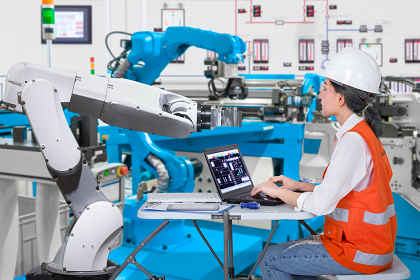
Microsoft and KRC Research conducted a study on the STEM industry named Closing the STEM Gap: Why STEM classes and careers still lack girls and what we can do about it.
Dr. Shalini Kesar, Associate Professor at the Department of Computer Science & Information Systems at the Southern Utah University, writes:
“For years, girls and young women have been a critical missing part of Science, Technology, Engineering and Math (STEM) studies and careers. The stubborn gender disparity in STEM fields has sparked important debates on the underlying reasons. Some attribute the gender disparity to social and infrastructural factors, lack of mentors and role models, and lack of awareness about what these fields offer in terms of educational and career opportunities.”
She says the archaically held view that engineering is ‘boring' and ‘only for boys' dissuades females from joining the industry. The report says girls ‘have a hard time picturing themselves in STEM roles.'
So, what can be done to convince girls that STEM is cool, a great career choice, and an industry to stay in until retirement? Schools are saying it starts in the classroom at an early age — STEM subjects and after-school clubs are the perfect way to do that.
Clubs for girls
Microsoft and KRC Research report that 44 percent of middle-school girls who participated in STEM clubs or activities, said they would likely continue engineering studies after school. Only 15 percent of girls who were not in STEM clubs or activities said they would pursue engineering studies after school.
The numbers (seemingly) don't lie: educators should implement better mechanisms inside their schools to get girls interested in STEM.
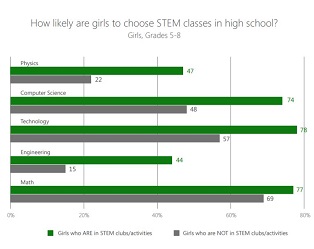
Another way to encourage young women to get involved in STEM fields is through mentorship programs with successful female engineers. Essentially, attracting and retaining females in STEM industries should be prioritized in a world calling for equal representation.
Dr. Shalini Kesar would agree and chalks the confidence she has in herself as a woman in STEM to the spurring on her parents did when she was younger. She wrote:
“My parents used to tell me that, ‘even if you are one drop of water in an ocean, it is those drops combined that make the ocean.’ Across southern Utah, I see a domino effect: when one girl sees the power in STEM and computing, she becomes a role model for her friends and community.”
Works Cited
“Our Insight, Your Breakthrough.” KRC Research, www.krcresearch.com/.
“The Engineering Mystery: Where Are the Women?” The Globe and Mail, The Globe and Mail, 6 Mar. 2019, www.theglobeandmail.com/business/careers/article-the-engineering-mystery-where-are-the-women/.
In the United States, the Midwest and Northeast have shivered their way through a winter they won't forget. They are calling it the coldest temperatures in a generation. If boiling water was thrown into the air, it would instantly freeze. The deep freeze is reminiscent of the Sci-Fi film The Day After Tomorrow.
The North Polar Vortex has caused these freezing conditions — it pushed Chicago's temperatures down to -46 degrees Celsius. That is colder than Antarctica, Alaska and the North Pole.

The vortex was disrupted at the north pole, ejecting strong winds high up in the atmosphere, traveling southward. These offshoots of the vortex retained the cold from the Arctic region and carried these to parts of America.
A state of emergency has been declared in Wisconsin, Illinois, and Michigan.
The wholly adverse side effects of the cold snap were the fatalities caused by it. The vortex affected the lives of more than 89 million people.
Schools were shut down, flights canceled, and the post office had to abandon their operations as well.
The engineering challenges
One of the biggest concerns with a deep freeze this potent was the infrastructure. How would it cope with the freezing temperatures? The first to freeze was the water infrastructure — the water mains froze over, essentially cutting the water off.
With winds picking up in the Chicago area, many were at risk of being without electricity as branches fell onto power lines. The lower temperature can also cause overhead power wires to contract and cause breakages and result in power outages. Some areas in Chicago were without power as the cold air was dumped on the city.
Consequently, engineers had to be called out to restore electricity to customers.
Soon after the polar blast came down on Chicago, the train tracks became a concern in the cold temperatures too. Reports started flying in that they were beginning to ice over completely. Civil engineers sprung into action to prevent the tracks from contracting and cracking due to the cold.
The engineers utilized the gas-fed system already fitted on the tracks to keep the flames going. In Chicago, the system is used during normal winters anyway — but this time it was working to its fullest extent. With the contracting of the steel, the snapping of the railways where they are bolted is possible. The fire allows the rail to expand again, where they can then be re-bolted or welded to the other tracks.
Experts are saying with the United States seeing more bomb cyclones and polar vortexes, closer attention should be given to climate events. This is because of the engineering works required before and after an incident. Climate change is proving that aging infrastructure globally may not be ready to withstand these events.
Works Cited
Gstalter, Morgan. “Chicago Using Fire to Keep Rail Tracks from Freezing in Polar Vortex.” TheHill, The Hill, 30 Jan. 2019, thehill.com/homenews/state-watch/427654-chicago-using-fire-to-keep-rail-tracks-from-freezing-in-frigid.
Williams, Corey. “Polar Blast Envelops U.S. Midwest, Strains Aging Infrastructure.” CP24, 30 Jan. 2019, www.cp24.com/world/polar-blast-envelops-u-s-midwest-strains-aging-infrastructure-1.4274848.
Hassan Mwanjali is an Engineering Institute of Technology (EIT) graduate who acquired his Advanced Diploma of Applied Electrical Engineering. He is currently working at the Diplomatic Mission at the Embassy of Japan in Tanzania as a Maintenance Engineer.
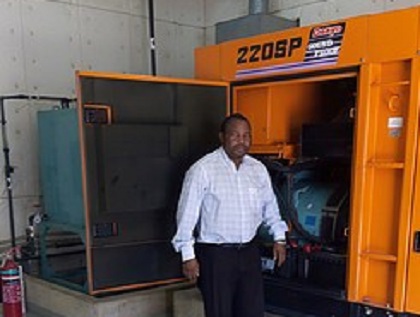
“I oversee the satisfactory conduct of property services including but not limited to Embassy of Japan general maintenance, power systems, power generators installations, and maintenance, electrical installation works, air conditioning works, water pumps, and plumbing works.”
He found EIT advantageous because he could both retain his position at the Embassy and he could professionally develop his engineering skills.
He is trying to reach his goal of becoming a fully decorated electrical engineer. He reckons that the technological growth of power electronics in the industry is fascinatingly developing.
“The gained knowledge and skills from the Engineering Institute of Technology enhanced my workmanship to a great extent. They added to my practical experience and hence made me execute my duties with more simplicity, more confidence, more accuracy and more expeditiously.”
Hassan utilized his time after hours and on the weekend to study and train through EIT, working through the syllabus, continually being motivated to complete modules and get to the finish line. Next, he would like to pursue his Bachelor of Science of Electrical Engineering through EIT.
Industrial automation can transform the landscape of a country's workforce and economy.
Countries are transitioning from mining economies, into manufacturing economies with the sometimes unseen fourth industrial revolution's slow march.
Berg Insights reported that 4.6 million wireless devices were shipped globally in 2018 for the purpose of industrial automation. Industrial automation accounted for six percent of newly connected IoT nodes. It also meant that the number of devices connected for Industrial Automation reached 21.3 million in 2018.

Wireless devices are flowing into the industry replacing previous technologies that do not have the kinds of monitoring and data generating technology that modern-day sensors and communication devices do.
The Berg Insights report also points out that smart wireless devices monitoring the entire manufacturing process will lead to more ‘predictive maintenance.' The likelihood of manufacturing equipment lasting longer than its predecessor has increased with the new Industry 4.0 technology emerging in the industry. As a result, there will be less wasting of money for maintenance and more for the payment of employees.
Rockwell Automation's On the Move event for 2019 was held in India. It saw industry leaders encouraging the country to embrace automation to turn India into a manufacturing economy.
Rockwell Automation is so interested in growing the manufacturing output of India that they have recently branched into the country. Dilip Sawhney, Managing Director of Rockwell Automation India, said:
“We want to take the lead in building India’s first industry 4.0 ecosystem of partner companies that will create solutions for The Connected Enterprise that can analyze machine conditions in advance to avoid breakdown and enhance productivity but also improve on quality and compliance parameters.”
John Watts, Regional Marketing Director, for Asia Pacific at Rockwell Automation added:
“Globally, digital-induced disruption is inevitable. To maintain and improve global competitiveness, Indian manufacturers need to accelerate the adoption of Industry 4.0. While India has a lot of catching up to do in this respect, it can accelerate digital transformation by leveraging its strengths in the IT services sector and tapping the entrepreneurial spirit seen in the start-up sector.”
The experts at Rockwell believe that if India adopts more automation technologies, their combined factory output would make manufacturing a US$ 1 trillion business by 2025. Rockwell Automation has partnered with L&T, Cisco, Microsoft, Endress+Hauser, and Wipro Infrastructure Engineering to help develop smart manufacturing solutions in India.
Works Cited
“Industry 4.0 Tech Can Triple India's Factory Output, Says Rockwell Automation.” Tech Observer, 22 Jan. 2019, techobserver.in/2019/01/22/industry-4-0-tech-can-triple-indias-factory-output-says-rockwell-automation/.
IoT.Business.News. “The Installed Base of Wireless IoT Devices in Industrial Automation Reached 21.3 Million in 2018.” IoT Business News, IoT Business News, 21 Jan. 2019, iotbusinessnews.com/2019/01/21/62655-the-installed-base-of-wireless-iot-devices-in-industrial-automation-reached-21-3-million-in-2018/.
Petro Chisale is never in one place for too long -- he goes where his electrical and instrumentation expertise is required. He graduated from the Engineering Institute of Technology (EIT) with an Advanced Diploma of Electrical and Instrumentation (E&I) Engineering for Oil and Gas Facilities.
After high school, Petro attended Masvingo Polytechnic in Masvingo, Zimbabwe to do an electrical power engineering course. After he obtained his qualification, he became a class one journeyman electrician with an industrial attachment at the then Rio Tinto Renco Mine.
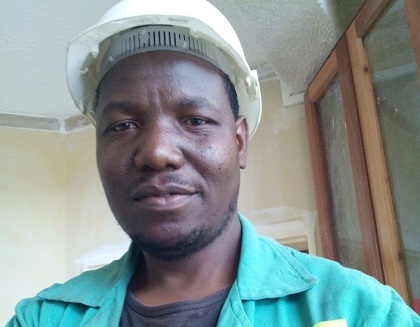
He later joined the National Oil Company as an electrician at the Beitbridge Oil Depot on the South Africa-Zimbabwe border. From there, he went into Harare to work as an assistant electrical technician before moving back to the border as a maintenance technician.
Currently, Petro is working at another oil terminal in Mutare on the border with Mozambique as a tank farm operator.
Every day he coordinates the receipts, storage, loading and transfer functions of quality cleared petroleum products. He produces all of the relevant reports for the management of the terminal. He also supervises assistant tank operators. The daily responsibilities of his roles include:
- Receiving products by road, rail and pipeline
- Plan for and clear petroleum products for loading in advance
- Monitor local and inter-depot transfers of petroleum products
- Accounting for all petroleum products
- Maintaining quality of the product in storage tanks
- Coordinating the suck back and spillage recovery programmes
- Tank farm security
- Supervision of subordinates
It sounds like quite a bit of work for one man to do, but Petro says the combination of interfacing with technology and field work is what he likes about the job. He said:
“I started my job at a remote oil terminal where there were no institutions to help improve myself through studying. I also found myself being transferred to different stations where I could not enroll or engage with conventional college setups. So, when I started online training, I discovered it was the best fit in my situation. As I moved from one oil terminal to the other, I would meet new technologies which coincidentally would be part of the program I studied.”
The fact that there is always something new to learn in the industry and to see new technologies getting implemented in it gives Petro the motivation he needs to keep going. He has already applied for the Bachelor of Science in Electrical Engineering with EIT.
We wish Petro all the very best in his challenging career and as he studies towards his Bachelor’s degree.
Universal access to clean drinking water is a challenge our world continues to face.
According to the World Health Organization (WHO), 2.1 billion people lack safe drinking water at home. That equates to 3 in 10 people worldwide. Moreover, twice as many people don't have access to basic sanitation.
The treatment of wastewater throughout the world is essential — that recycled water is used as drinking water in some cases.

Students and professors at the University of New South Wales and the Australian National University have for years been trying to develop what they believe is a new low-cost alternative to killing bacteria in wastewater.
Professor Ninham told The Australian:
“The work is the culmination of 40 years of pure undirected curiosity-driven research. In particular, the cost and destruction caused by viruses in water remains an unresolved challenge and poses a major limitation on the use of recycled water. Here, we develop an environmentally friendly technology for sterilising water.”
This particular methodology is being touted as a world first. The universities say their treatment methods have sterilized the water from bacteria, diseases, and drugs. These diseases include E-coli and potentially even Ebola.
The scientists engineered new technology that utilized carbon dioxide (C02) as a way of treating wastewater. They reached the conclusion that the C02 was instrumental in killing bacteria and eliminating the viruses present in the dirtiest kinds of water. The researchers noted that C02 was an essential factor in nature, in the way that it killed viruses and prevented infections.
These findings were published in the Nature journal. This treatment method had also proven useful for bringing the price of desalinating water down. Researchers found they were able to eliminate heavy metals like arsenic, lead, mercury, and radioactive waste through a novel bubbling process. Professor Ninham said:
“The technology bubbles heated unpressurised carbon dioxide or exhaust gases through wastewater in a bubble column, effectively destroying both bacteria and viruses. The process is extremely cost-effective, with no concerning by-products."
Similar work is being done all over the world, to develop new technologies for water treatment. Scientists and engineers are finding new ways to treat water that don't involve mechanical filters and membranes.
A system was also developed at Princeton University in 2017. The low-cost silicone rubber tube splits into two channels. Pressurized C02 goes through one of the channels, and the water goes through the other.
The carbon dioxide gas then mixes with the water, creating charged hydrogen and bicarbonate molecules. They separate the wastewater particles and let the filtered water pass through.
The Australian technology allows unpressurized C02 to be used in treating the water.
The Australian researchers say that their way of doing things will lead to less plastic bottle waste due to the treating of water straight from the source, and will also bring down the number of Ebola outbreaks in places like Africa.
Works Cited
Quick, Darren. “‘SodaStream’ Technique Delivers Low-Cost, Filter-Free Water Purification.” New Atlas - New Technology & Science News, New Atlas, 16 May 2017, newatlas.com/princeton-water-purification-filterless-c02/49534/.
The Australian. Carbon dioxide kills viruses, bacteria in the water. https://www.theaustralian.com.au/news/health-science/carbon-dioxide-kills-viruses-bacteria-in-water/news-story/a5e0f9d87f3b3a636eefc9d119175066
Dear Colleagues
As we all know – projects fail at a regular rate. Particularly software projects. Gary Klein has referred to doing a thorough review of a project before it actually commences by visualising that it has finished in outright failure – something he labels a pre-mortem.
We all do post mortems on projects – particularly ones that flame out spectacularly and where one often is seeking to…. as the old adage goes: ‘to reward the guilty and punish the innocent.’ So this is an innovative suggestion to think about what could go wrong with the project before it even commences.

The suggestion for a pre-mortem from Deborah J. Mitchell (et al.) of Wharton School of Business is to imagine that the project has already occurred, and to detail the reasons for failure. This is said to help improve the identification of risks ‘by 30%’. I do wonder about the precision quoted here, but nonetheless, the concept is good.
The Trick
What team members are expected to do at a pre-mortem session is to imagine the project has been concluded, and there have been multiple sources of failure. The idea then is to identify what these failures are.
How do we do it?
It is relatively simple. The project team is gathered together, and an action-packed summary is given of the overall project – particularly resources required, critical elements, and outcomes desired with timelines clearly defined.
The Project Manager then asks everyone to visualise that we have concluded the project but that it has failed spectacularly. She then requests everyone to write down independently what the reasons for failure are (in an anonymous manner). They are to be as imaginative as possible in their thinking. Nothing is too far-fetched to consider. All the reasons are then read out by the project manager and discussed by the team. Hopefully, a series of action points are then taken as a result of this meeting.
Typical examples of Successful Pre-mortems
A list of a few interesting ones include:
The construction of a power station in a remote area was considered where potential failure was attributed to the main contractor going bust due to miscalculating the construction delays due to the impending rainy season. This assessment then resulted in safeguards being put in place to protect the client from the financial failure of the contractor. On the real project, this almost happened but the additional financial safeguards protected the client.
The impending construction of an iron plant was considered for the situation where the valuable electronics of the variable speed drives were damaged by an unexpected voltage spike through the system. Additional safeguards with surge protection were put in place on the project at significant additional cost. On the real project, there was indeed a voltage spike due to the installation of power factor correction equipment unconnected to the project. The sensitive electronic equipment was protected.
Finally, consideration was given to a large industrial PLC programming project for a control system as to the loss of some of the key programmers halfway through the project. Additional support programmers were put in place to critique the code. And, one of the key architects of the programming did get seriously ill. This protected the programming schedule.
What are the benefits of this pre-assessment process?
Besides the apparent major benefit of avoiding a project failure, other benefits include team members feeling valued no matter how outlandish their opinions are. It also fine tunes the antennae of team members to look out for potential problems and to be pro-active about dealing with them. Along with my usual mantra of 'When there is any doubt, there is no doubt.'
Thanks to Gary Klein for a thought-provoking discussion in Harvard Business Review.
Winston Churchill makes a brilliant remark relating to pre-mortems: "Let our advance worrying become advance thinking and planning."
Yours in engineering learning
Steve
Making computers think like humans is undeniably the next frontier that scientists and engineers are to trying to reach.
However, machine learning, a field of computer science that programs computers with the ability to learn from data and make informed, adaptive, dynamic predictions, is currently reinventing the wheel in engineering industries.
In the last decade, technology has taken a gigantic leap forward. Machine learning has empowered these technologies, and today we have virtual assistants, speech recognition, incredible consumer products, and more.
Governments around the world are now trying their best to out-AI other governments. And that’s a good thing for future engineers.

It seems that China has sent alarm bells ringing around the world with their artificial intelligence aspirations and apparent capabilities.
The United States of America doesn't want to be left behind. The White House just published an executive order on ‘Maintaining American Leadership in Artificial Intelligence.' President Donald Trump said:
“We’re on the verge of new technological revolutions that could improve virtually every aspect of our lives, create vast new wealth for American workers and families, and open up bold, new frontiers in science, medicine, and communication.”
The new executive order is a national strategy with the intention of prioritizing funding for ‘fundamental AI research and computing infrastructure, machine learning, and autonomous systems.'
Engineers have managed to make the rest of the world perk up and listen, with their innovative inventions utilizing artificial intelligence and machine learning.
However, it is not only China and America throwing their hats in the ring. Forbes Magazine reports that Russia, Japan, Estonia, Israel and Canada, are major global players in the AI and machine learning sectors too.
Most prospective engineering students globally, however, are eager to learn more about artificial intelligence and machine learning. They are seeking to earn qualifications in the space as well.
If the benefits of AI, machine learning and autonomous systems are clear, then many other countries should turbo-charge their uptake of the studying of these sectors.
Engineers studying at this very moment might have never been introduced to the learning materials that could assist with becoming knowledgeable about machine learning and artificial intelligence. So, how does the empowering of all engineers and technologists who could bring about the peak of the fourth industrial revolution begin?
Globally unlocking AI and machine learning
The Engineering Institute of Technology is presenting a Professional Certificate of Competency in Machine Learning and Artificial Intelligence. The course will begin on 13 May 2019.
In a short three months, students can become competent in the following areas of artificial intelligence and machine learning:
- Demonstrate an understanding of machine learning and its basic techniques
- Solve problems using search algorithms
- Examine and discuss Simultaneous Localization and Mapping (SLAM)
- Solve problems using supervised learning methods
- Use WEKA software for data analysis and machine learning
- Solve problems using mathematical optimization
- Use MATLAB for machine learning
The course is delivered industry lecturers with more than 15 years of experience in the development and management of artificial intelligence. The course teaches students incredible problem-solving skills in the machine learning world and trains them in building algorithms to automate processes.
To join the course, all the students need is a computer with an adequate Internet connection. At the end of the course, the future AI whizzes will receive a certificate of competency and be ready to learn and apply what they have learned in the actual industry.
Enquire about the course today.
Works Cited
“Artificial Intelligence for the American People.” The White House, The United States Government, www.whitehouse.gov/briefings-statements/artificial-intelligence-american-people/.
Minevich, Mark. “These Seven Countries Are In A Race To Rule The World With AI.” Forbes, Forbes Magazine, 5 Dec. 2017, www.forbes.com/sites/forbestechcouncil/2017/12/05/these-seven-countries-are-in-a-race-to-rule-the-world-with-ai/#181ff94f4c24.
“Professional Certificate of Competency in Machine Learning and Artificial Intelligence.” Engineering Institute of Technology, www.eit.edu.au/cms/courses/electronic-engineering/professional-certificate/in-machine-learning-and-artificial-intelligence.
Dear Colleagues,
Surely, the KISS principle is one of the most useful engineering tools we have in our armory (KISS means Keep it Simple Stupid, for those who have forgotten). This should be applied to our writing so that it is simple and easy to understand.
But this principle is often forgotten. Perhaps, the overriding consideration we mistakenly have is to impress our audience with lots of gigantic words. I believe it is a privilege when someone is reading your communications. Therefore, you should ensure you respond appropriately to make it as easy as possible to understand what you are endeavoring to get across.
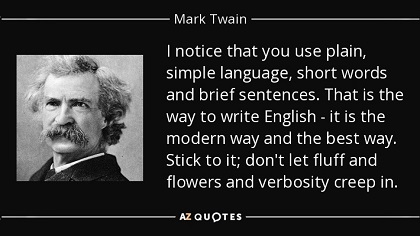
Engineering Professionals
Most of the communications that engineering professionals write are to colleagues – in my opinion – and this results in the use of lots of technology gobbledygook. Obviously one doesn’t want to descend to childish levels and treat one’s audience like complete orangutans with overly simple English, but a balance is required.
This problem of poor written English applies to all groups of engineering professionals – from the handy(wo)man, electrician, fitter to the Chief Engineer. My wife (being an ex-English teacher) often rips my (what I thought was) well-written prose to shreds because it is too clumsy or badly structured. So I am not immune to accusations of poor writing skills.
Examples
Simple measures of poorly written English include the average number of words in a sentence and the average number of syllables. But these aren’t always appropriate.
As we all know - probably the profession which is the most guilty of jargon-riddled communications are lawyers. Lawyers retort that they need to write with ‘legalese’ to ensure that they are consistent, specific and guarantee a common interpretation by all parties.
Here are examples of words that are hard to understand and consideration should be given to more straightforward language: abatement, interlocutory, malfeasance, turpitude and the list goes on…
A few suggestions:
• Briefly consider who your audience is (e.g., immigrants/a bunch of PhDs or farmers)
• Think about adding graphics to break up the text and to enhance the understanding
• If you are looking to justify your assertions, some backing references are always good
• Choose simple, effective words
• Keep your sentences short
• Keep paragraphs to about twelve lines with about twelve words per line
• Text size of 11 to 12-point is easily readable.
But don’t ask me about sans-serif vs. serif fonts – no one seems to agree here.
Graphics Rule
Finally – I had to laugh ruefully – if you are putting up signage in a zone with visitors who don’t understand English very well – it is probably a good idea to use lots of graphics to get important concepts across (such as “Snakes are in this area”). Words may not always be understood.
Leonardo da Vinci reminds us: Simplicity is the ultimate sophistication.
Thanks to the inimitable Don Christiansen of the IEEE for his write-up on this vital topic.
Yours in engineering learning
Steve
Gorataone is a graduate from the Engineering Institute of Technology; he has an Advanced Diploma of Industrial Automation. He is also a married man with three children; we congratulate him for ably juggling full time work, a family and his studies!
His career in the engineering world began at the Debswana Diamond mine in Botswana. While at the mine he became a control and instrumentation technician and, within the coal-fired plants, he worked with a 33MW pulverized boiler and 600MW fluidized circulating air boiler. His daily responsibilities included the calibration, troubleshooting and maintenance of process equipment. Naturally he was also involved in the safety of the plant at all times too.
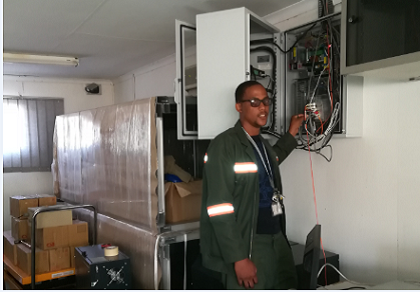
The qualification from EIT gave him the skills to progress in the mine: from working in the process control and instrumentation departments he has now moved to the access control and surveillance departments.
“The main reason I chose this course was to stay up to date with the ever-changing technology in this digital world,” Goratoane said.
He also noted that the convenience of studying after hours ensured he was able to cope with his busy and often conflicting schedule.
In his new role Goratoane’s duties include controlling the access to the various and colour-coded areas of the mine:
- White - the township area
- Green - the mine pit
- Red - recovery and sorting plants
Goratoane explained that these areas are under intense surveillance due to precious gemstones being mined. He also commented that the industry is seeing more and more integration with the Internet of Things and general automation.
“The most interesting development in the industry is the use of smart instruments which can be calibrated, diagnosed and operated remotely. The use of smart trucks at the mining pit is amazing as well - they even perform alcohol tests on the drivers, to check their fitness prior to driving; this protects the most valuable assets of the company.”
Gorataone mentions that he next wants to pursue qualifications in cyber security. The Engineering Institute of Technology has a Professional Certificate of Cybersecurity for Automation, Control, and SCADA Systems; a 6 week course. It equips students with the principles in digital security which can be applied to the infrastructure found in engineering industries.
The prototype of the world's longest aircraft is being retired, with new aircraft innovation promised to hit the market soon.
The aircraft in question was the Airlander 10: a weirdly shaped plane-airship/blimp that showed what the future of air travel could look like. Needless to say, it does not look like your regular Airbus.
It was the product of Hybrid Air Vehicles (HAV), a company based in Virginia in the United States. The company surprisingly obtained the Civil Aviation Authority's (CAA) approval and are now confident that they can build their final prototype and take it to the skies in 2020.
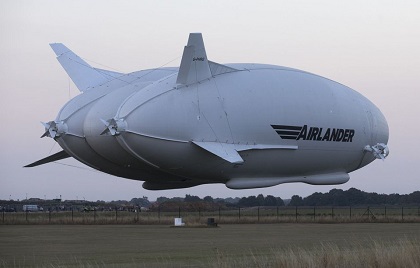
Social media was not kind to the shape of the aircraft, with some calling it ‘the flying bum.'
The prototype — which looks like it flew out of a science fiction novel — went through its fair share of trial and error. The prototype crashed nose-first in 2016 on its maiden flight. Luckily, no one was hurt. Regardless, the engineers are working on ironing out all of the kinks and are ready to go to market in 2020.
Stephen McGlennan, the company’s CEO said:
“Our focus is now entirely on bringing on bringing the first batch of production-standard, type-certified Airlander 10 aircraft into service with customers. The prototype served its purpose as the world’s first full-sized hybrid aircraft, providing us with the data we needed to move forward from prototype to production-standard. As a result, we do not plan to fly the prototype aircraft again.”
Nonetheless, the final prototype is expected to look similar in regards to the interior. The 2012 prototype was named the world’s most luxurious aircraft. The aircraft is ultra-spacious in the inside, it even has an en-suite bedroom, an Infinity Lounge with panoramic views, and a glass floor that will allow travelers to see what is below them from 16,000 feet up. There is even a bar on board.

The Airlander is targeted at travelers who are looking for an extended holiday in the skies. McGlennan said:
“Air travel has become very much about getting from A to B as quickly as possible. What we’re offering is a way of making the journey a joy.”
Even though the prototype has been through the (engineering) wringer, the engineers are presumably ironing out the kinks and ready to revolutionize what people think air travel looks like. The Airlander does not need a runway, it can take off - and land - on any flat surface.
And what might one of these Airlanders cost, you might ask? The original model cost a cool US $25 million.
Plane or blimp?
HAV is not the only company trying to harken back to the days of the blimp or airship, a company named Plimp is also hard at work reintroducing the form of travel back into the mainstream.
They have just announced their new Model J Plimp airship. It is being touted as a new class of aircraft, developed by the engineers of Egan Airships. They say that the Plimp is plummet-proof and is ultra-safe.
They advertise it as part-plane, part-helicopter, part-blimp. It seems that the world should anticipate more hybrid aircraft. The company says they have not invented any new technology - the technology needed to design a Plimp is all off-the-shelf.
The reality of these hybrid aircraft engineering companies is that they are tough to get off of the ground. Both Airlander and Plimp, with their wheel-reinventing ideas in the aircraft industry space, are trying to build sustainable businesses out of their endeavor. That is the tough part for these entrepreneurs. Plimp has patented their design, and they're ready to roll out their eight-passenger blimp if anyone in the market is interested.
Works Cited
Boyle, Alan. “Egan Airships Floats a Sales Campaign to Get Its Plimp Hybrid Aircraft off the Ground.” GeekWire, GeekWire, 8 Nov. 2018, www.geekwire.com/2018/egan-airships-floats-sales-campaign-get-plimp-hybrid-aircraft-off-ground/.
Sky News. "Airlander 10: World's Longest Aircraft to Go into Production and Offer 'Luxury Expeditions.'" Sky News, Sky News, 14 Jan. 2019, news.sky.com/story/airlander-10-worlds-longest-aircraft-to-go-into-production-and-offer-luxury-expeditions-11607125.
India's most famous civil engineer, Sir Mokshagundam Visvesvaraya, once said: ‘Work is worship.'
Gustave Eiffel, the French civil engineer responsible for the Eiffel Tower, said: “Can one think that because we are engineers, beauty does not preoccupy us or that we do not try to build beautiful, as well as solid and long lasting structures? Aren’t the genuine functions of strength always in keeping with unwritten conditions of harmony? Besides, there is an attraction, a special charm in the colossal to which ordinary theories of art do not apply.”
Marvels of civil engineering are evident throughout history. Even today, humans are trying to push the boundaries of what is possible.
However, what exactly draws prospective engineers to the civil engineering profession? Why do civil engineers do what they do? How can they improve the world in the future?

The Civil Engineering Contractors Association, a construction organization in the United Kingdom, wants to answer those questions. They have published a report entitled: ‘The social benefits of infrastructure investment.'
The association brings together 300 civil engineering member companies across Scotland, Wales, and England. Altogether, they represent 70 to 80 percent of all civil engineering activity in the UK. They are present in critical sectors including transport, energy, communications, waste, and water. With the uncertainty of Brexit looming, the association is reminding civil engineers to remain dedicated to the noble profession.
Building a better world?
The association says that building infrastructure leads to social cohesion. However, more needs to be done to establish a purpose for the workers building the infrastructure that generates the ecosystem of a city. In the report, they write:
“The social and economic benefits of infrastructure are closely related. While quality of life, health and social inclusion have become increasingly important factors in long term economic prosperity, the mechanisms by which infrastructure influences these factors are considered much less measurable than simple economic benefit.”
The report encourages civil engineers to find the gaps in society where they could assist in developing hubs of business and prosperity. They say this is attainable by starting within their communities. They write:
“Solving Britain's housing crisis is not simply a question of building a certain number of new homes, but ensuring that there are opportunities for people to have access to the housing they need where they want to live.”
Investment into infrastructure in communities who might need it most develops, the report says, ‘more productive and interesting work that enables people to develop their skills and knowledge.' Thus, civil engineering can help others find their way in their careers too.
Arup, an independent firm of designers, planners, engineers, consultants and technical specialists with offices in the UK, is also redefining the fashion in which they instill social value in their projects.
Arup associate director for sustainability and social value, Alison Ball, talking to the New Civil Engineer publication said:
“Many things come together to form the social value of the project, such as health and wellbeing, crime and safety, identity, pride and belonging, community cohesion and diversity, geography, and stakeholders. We also think that added into this we need to take a total value approaching asking: ‘what are the natural and environmental benefits?’, and the negatives, the financial values, as well as the economic values?”
In 2018, the public opinion of the social value of civil engineering projects was unfavorable due to highly publicized structural failures in the United States and Italy. It produced fresh cynicism for civil engineering projects that lack constant maintenance.
The year 2019 will test already existing infrastructure and its maintenance. Building new structures while not maintaining the old infrastructure will undercut the social value design that firms and new civil engineering companies are trying to contribute to.
Consequently, prospective engineers entering the industry must ensure that wherever they find themselves in the industry, they do a good job and pay attention to detail.
Works Cited
16 January, 2019 By Connor Ibbetson. “Debate | Determining the Social Value of Projects.” New Civil Engineer, www.newcivilengineer.com/business-culture/debate-how-can-engineers-determine-the-social-value-of-projects-/10038890.article.
“Home.” CECA, www.ceca.co.uk/.
In January 2019, the Consumer Electronics Show kicked off in Las Vegas, Nevada. And it seems mechanical engineering, propped up by artificial intelligence, is the talk of the town.
Mercedes-Benz rolled their latest marvel of mechanical engineering out on the floor, touting some impressive artificially intelligent add-ons. The car’s name is the 2020 Mercedes-Benz CLA 250 Coupe, and the AI software is called MBUX (Mercedes-Benz user experience).
The company’s presentation kicked off calling the CLA ‘The most bling-bling gadget’ at the expo. You can even talk to the car by calling out the words, “Hey Mercedes,” and follow it up with a command you want the car to perform - like rolling up the windows. It also has hand gesture recognition.

There are also semi-autonomous features that help the car drive; further propelling the car industry into a self-driving future. Moving to an artificially intelligent car, empowered by software, is a watershed moment for automobile engineering - it shows that car companies are becoming far more multifaceted.
It also signals an interdisciplinary move in the automobile industry, bringing many engineering industries into one. But, the Head of Group R&D at Mercedes-Benz, Ola Kallenius, says the company itself is also changing the way it operates as a company. Speaking at CES 2019, he said:
“Speaking of the future, we show very clearly where the technologies of our company are heading. Our vehicles are now platforms of digital progress and we operate as a software company with more flexibility and adaptiveness, with agility to do developments and customer requirements [faster]. Our goal is to build trailblazing mobile devices that enhance our customers’ lives.”
The car can also integrate with wearables. The smartwatch informs the car how its driver is feeling. Consequently, the car can then offer massages and hotter or cooler seats. Using the heart rate monitor will also fill the car in on how stressed the driver is. The MBUX system was designed in conjunction with Nvidia. This further highlights how engineering industries that may have previously existed independently, now regularly collaborate to create new products in the future.
Real Robots
Humanoid robots seemed to attract the most journalistic cynicism at the CES event this year. Purportedly the robots at the 2019 expo were a little disappointing; lacking the expected sophistication or improvement when compared with the 2018 expo. It seems that consumer robots are still a bit too clunky to be considered ready-for-market.
The online publication, The Verge, believes that the delivery robots were the most impressive and with the most future-proof uses - namely, delivering items or food to the consumer.
Pudutech had a robot rolling around the CES floor named the HOLABOT. It is equipped with AI speech and face recognition functionality and is specifically designed to deliver food to a customer inside a restaurant. Pudutech is the company looking to be the leader in delivery robots and self-driving low-speed robots. And their multi-robot deployment system will help - it enables one hundred HOLABOTs to work at the same time.
The robots that were highly regarded at CES 2019 may indicate which ones will see huge corporate and consumer uptake (the first cousins of robots like the Roomba vacuum cleaner).
Works Cited
Eisenstein, Paul A. “Mercedes' New CLA Coupe Loaded with High-Tech Extras in Clear Pitch to Millennial Luxury Buyers.” CNBC, CNBC, 9 Jan. 2019, www.cnbc.com/2019/01/09/mercedes-cla-coupe-loaded-with-high-tech-extras-to-lure-millennials.html.
Vincent, James. “The Five Types of Robots You Meet at CES.” The Verge, The Verge, 9 Jan. 2019, www.theverge.com/2019/1/9/18175168/ces-2019-robots-best-worst-delivery-butler-tablet.
Pearlitic steel, or pearlite, is one of the most durable materials in the world. This microstructure occurs in steel and can be made into steel wire.
You might have seen these wires bundled together into ropes for suspension bridges or steel cords for tire reinforcement. They are also prevalent in piano wires.
Kanazawa University students in Japan have been studying its atomic structure and have made a few first-time discoveries. They hope the atomic properties present in pearlite could be applied to newer materials to ensure bridges and buildings sustain less damage during earthquakes.
In their published findings, titled ‘Proposed engineering method could help make buildings and bridges safer,' the researchers report that they were able to ascertain the distance between locations in nanolayer interfaces in pearlite. The university’s news website writes:
“Perlite is made of alternating nanolayers of cementite and ferrite. The cementite helps make it strong, while the ferrite helps make it ductile. However, until now researchers did not know exactly how the two worked together to give pearlite its special quality, or better yet, how to control their working together to engineer an even better material.”
The researchers discovered that the disruptions, or dislocations, in the arrangement of atoms along the interface between a cementite and ferrite layer protect the layers from fracturing or stretching or compression.
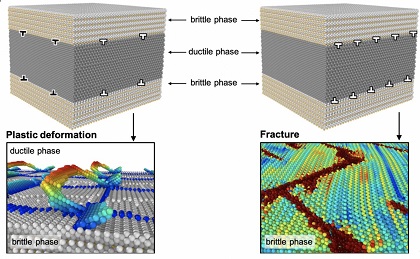
Pearlite is often used in the construction of suspension bridges — it helps the bridges withstand shaking, and also supports a lot of weight.
The researchers studied how the material performs under stress. They found that pearlite prevented cracks from forming and spreading at the atomic level. Therefore, its elasticity is guaranteed.
These findings are particularly pertinent to civil engineers in countries affected by seismic activity.
For example, Mexico City in Mexico is located atop an ancient lake. Once an earthquake occurs, the sand and clay sediments in the lake intensify the severity of the shaking.
This leads to immense damage.
With these new pearlite findings in Japan, building materials could be strengthened to withstand severe earthquakes.
Now engineers are equipped with the knowledge of the dislocations in the nanolayer interfaces of pearlite, they can begin experimenting with ways of transferring that atomic makeup into other materials.
Works Cited
“Proposed Engineering Method Could Help Make Buildings and Bridges Safer.” ScienceDaily, ScienceDaily, 17 Jan. 2019, www.sciencedaily.com/releases/2019/01/190117102359.htm.
“金沢大学.” 金沢大学へ移動, www.kanazawa-u.ac.jp/latest-research/64033.
National Aeronautics and Space Administration (NASA) has been working on nano-electrofuel (NEF) flow batteries for electric aviation.
This means they could eventually power aircraft with non-explosive liquid rechargeable batteries.
The development of these flow batteries is being done by the Armstrong Flight Research Center's Aqueous Quick-Charging Battery Integration for Flight Research (Aquifer) within NASA. The aerospace company has always been innovative in the flow battery space — they invented a functioning flow battery back in the 1970s.
NASA says the flow batteries they are developing will have a higher energy density than solid lithium-ion batteries. However, there is a debate as to whether liquid batteries are better than solid-state batteries, particularly when it comes to electric vehicles.
Liquid vs. solid-state
Lithium-ion batteries are made up of liquid electrolyte solutions that utilize an anode and cathode system. A solid-state electrolyte results in a smaller battery with a higher energy density, using a lithium metal anode.
In the electric vehicle industry, liquid-based lithium-ion technology is being called into question. This is a result of fires that have occurred due to the bigger battery banks and the flammable liquid within the cell. Consequently, the industry is starting to pay a lot more attention to solid-state technology.
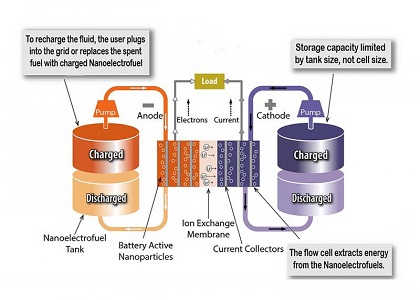
Solid-state batteries would be less prone to leaking or bursting into flames. They are also considerably smaller than liquid-based batteries. Researchers are indicating that solid-state batteries with a lithium metal anode might enable electric vehicles to travel longer distances than they already do with liquid-based batteries.
However, it seems the car manufacturers are struggling to find a solid-state solution that works for them.
But some companies are going ahead with developing Vanadium Redox Flow batteries — an energy storage technology that organizations like NASA are looking into. The other benefit of the redox battery is that it can be recharged faster than a lithium-ion battery.
The Vanadium Redox Flow batteries are liquid batteries, but unlike normal liquid cells, the electrolytes are housed in tanks outside the cell. These cells work by pumping the liquid into a stack of cells, where the electromechanical reaction takes place and electricity is produced. And word on the street is that they are less explosive than traditional liquid batteries.
NASA Electrical Engineer, Kurt Papathakis told media:
“We have demonstrated multiple recharge cycles and seen minimum to zero degradation. Also, unlike Li-ion batteries, NEF does not pay a penalty in cycle life for charging above 80-percent capacity or discharging below 20 percent.”
Cobalt, lithium, and vanadium are subsequently the most in-demand elements seeing a global demand in the energy storage industry.
Taking to the skies
It's not only NASA that are looking to power electric aircraft in the sky...Rolls-Royce is too. The company plans to launch an all-electric aircraft in 2020. They are also eyeing a world speed record for the plane — the engineers are looking to design an electric plane that can reach a top of speed of more than 300mph. They’re calling it the ACCEL.
The current title holder is the Siemens Extra Aircraft 330LE. It currently boasts the world's most powerful electric motor in an aircraft. It is powered by battery packs and is a joint engineering venture with Extra Aircraft, Siemens, MT-Propeller, and Pipistrel. The company reckons that passenger flights in small electric flights could happen as soon as 2025.
Rolls-Royce is working alongside a company named Electroflight and YASA on their project.
The most important benefit of battery-powered aircraft will be that they emit zero emissions.
Matheu Parr, the ACCEL Project Manager for Rolls-Royce said:
“This plane will be powered by a state-of-the-art electrical system and the most powerful battery ever built for flight. In the year ahead, we’re going to demonstrate its abilities in demanding test environments before going for gold in 2020 from a landing strip on the Welsh coastline.”
Works Cited
“Introducing ACCEL.” Rolls-Royce, www.rolls-royce.com/media/our-stories/innovation/2018/introducing-accel.aspx.
Robinson, Isabelle. “Using Liquid Batteries for Electric Aircraft.” AZoCleantech.com, AZoCleantech.com, 18 Jan. 2019, www.azocleantech.com/article.aspx?ArticleID=843.
The World Economic Forum is inviting other industrial companies to study nine world-leading smart factories they have identified as having the latest in automation technology.
Not surprisingly, these ‘manufacturing lighthouses' as the WEF call them, utilize the Industrial Internet of Things, and in their opinion show the most promise in Fourth Industrial Revolution implementation.
WEF are helping build seven more to join the other nine already in existence.
Factories are becoming far more automated with communications and networking technologies that can integrate with modern day smartphones and remote technologies. The world has witnessed the advent of 4G in the last few years, which transformed the speed of access to the internet and created interconnected networks within factories.
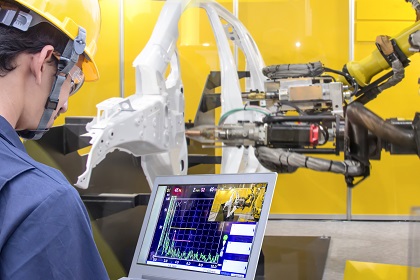
But 4G's successor is here, and it is unsurprisingly called 5G. The technology is boasting more bandwidth and faster speeds.
However, rolling it out across the world is going to take the building of some new infrastructure.
Nonetheless, many novel applications for 5G have been touted in the media. These include connecting all vehicles on the road to an autonomous driving telecommunications server, hosting entire virtual reality worlds that users can log in into, speedy mobile internet infrastructure, and industrial automation.
Now, countries are racing to be the first to implement the new technology. Chinese companies Huawei and ZTE appear to be frontrunners in the testing of 5G technologies. Qualcomm is one of the American companies making progress designing modems and technology to process the signals broadcasted by 5G antennas.
Ericsson, a company also dedicated to shaping the future of mobile broadband internet communications, says that before 5G is used on products like smartphones and home-based internet, it will go to the factories. They write:
“In our market research we have identified the most crucial manufacturing use case categories that 5G will enable operators to address. These include industrial control and automation systems, planning and design systems, and field devices.”
Ericsson is confident that 5G technology will create the smart factory of the future, made more efficient by the Industrial Internet of Things, powered by 5G internet speeds. 3G and 4G technologies have been classified unable to meet the demands of the cyber-physical manufacturing systems (CMPS) that manufacturers are eager to employ in their factories.
Engineering a technology war
5G is also quickly becoming a bone of contention in geopolitics.
The United States Air Force Brigadier General Robert Spalding told Bloomberg that China's progress on 5G was something the US should be aware of. He said:
“The more connected we are, and 5G will make us the most connected by far, the more vulnerable we become.”
Soon after, the Chief Financial Officer of Huawei, Meng Wanzhou, who is also the daughter of the company's founder, was detained in Canada on request of the US.
Then came the announcements that Huawei would be banned from operating 5G technologies in the US, Australia, New Zealand, Japan, and most recently, Norway. The United Kingdom is currently debating whether to rip out Huawei infrastructure as well.
The US claims that Huawei was not cooperating with an investigation into Huawei's relationship with the Chinese government and the Chinese Communist Party.
Countries who are banning China's no-doubt impressive 5G technologies must figure out how to implement 5G networks by themselves, for now.
The US is particularly worried about what access the Chinese government will have to the data generated by running mobile internet infrastructure in other countries. They claim security vulnerabilities and the supposed connections Huawei has to the Chinese military is enough reason to discourage the use of their technology.
Huawei did, however, hit back after the arrest of their CFO, and said customers can make their own decisions in this technology war — and said they would push on with 5G technology implementation in countries who would work with them.
Consequently, we may have to wait a little longer for the 5G revolution. Until then, the World Economic Forum will be showing off what's possible in their ‘manufacturing lighthouses' and trying to push the fourth industrial revolution that much further.
Works Cited
“5G For Manufacturing and Industrial Automation Technology.” Ericsson.com, 5 June 2018, www.ericsson.com/en/networks/trending/insights-and-reports/5g-for-manufacturing.
Leurent, Helena, et al. “The Fourth Industrial Revolution and the Factories of the Future.” World Economic Forum, www.weforum.org/agenda/2018/08/3-lessons-from-the-lighthouses-beaming-the-way-for-the-4ir/.
Santo, Brian. “5G And Autonomous Vehicles Might Not Go Hand-in-Hand.” EDN, www.edn.com/electronics-blogs/5g-waves/4461460/5G-and-autonomous-vehicles-might-not-go-hand-in-hand.
Artificial Intelligence may be the key to empowering rural education and ensuring a future where no students get left behind.
At least that's what venture capitalist Kai-Fu Lee believes.
The momentum behind Artificial Intelligence does not seem to be slowing down. Some of the biggest companies in the world are utilizing it: Google, Amazon, Facebook, Tesla.
According to Kai-Fu Lee, the best place to capitalize on AI is China. It's there that he is known as the Oracle of AI. He is also a former employee of Google, Apple, and Microsoft.
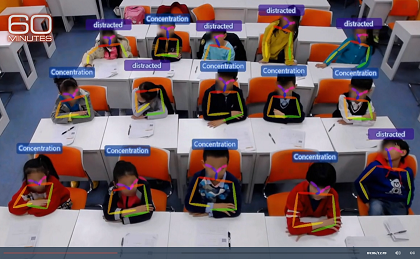
Speaking to CBS' 60 minutes, he said most people around the world have no idea how quickly AI is advancing.
"I believe it's going to change the world more than anything in the history of mankind. More than electricity.”
He has funded 140 AI start-ups. His Beijing venture capital firm has supported approximately ten one-billion-dollar companies.
In 2017, China's technology markets received half of the global AI capital.
One of the major areas of AI emerging from China is recognition technology. This technology scans images and CCTV footage to identify everyday objects, as well as people.
As it turns out, Chinese educators have found a place for AI recognition systems in education.
TAL Education Group is investing in technology that detects emotions on human faces to determine their feelings. They tutor five million Chinese students across the country.
The beauty of this software is that it can pinpoint students who look lost or confused, so the teacher realizes they need extra attention. It can also pick out students who are gifted.
"It can also create a student profile and know where the student got stuck, so the teacher can personalize the areas where the students need help," said Kai-Fu Lee.
Another one of his projects is the designing of software that sees some of the top teachers in China broadcast via the Internet to students in one of the most impoverished schools.
In 2010, approximately 70 million children in rural China were left behind by their parents, who were pursuing high-paying jobs.
Often these children are poor academic performers due to the lack of premium educational institutions in their rural communities. Most of these students don't make it past ninth grade.
According to a study entitled ‘China’s Rural Education: Chinese Migrant Children and Left-Behind Children,' the separation between child and parent has ‘substantial adverse effects on these youth's development.'
Kai-Fu Lee said he hopes this new technology can give these children the same opportunities he had when he moved from Taiwan to the US.
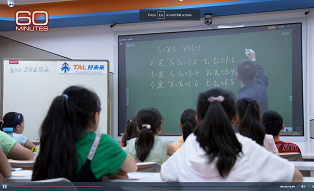
"When I arrived in Tennessee, my principal took every lunch to teach me English. And that is the kind of attention that I've not been used to growing up in Asia. And I felt that the American classrooms are smaller, encouraged individual thinking, critical thinking. And I felt it was the best thing that ever happened to me."
This experience has led him to employ dozens of engineers to create education platforms to deliver the same quality of education he was privileged enough to receive.
The Internet has created the opportunity for educational institutions to broadcast their premium educators and content into rural communities.
In this way, AI could transform the education market.
However, while AI may be a game-changer for the education sector, its effect on jobs — if left unchecked — could be catastrophic.
Kai-Fu Lee believes up to 40% of the world's employment could be displaced as AI overtakes repetitive jobs.
"Chauffeurs, truck drivers anyone who does driving for a living their jobs will be disrupted more in the 15 to 20-year time frame and many jobs that seem a little bit complex, chef, waiter, a lot of things will become automated we'll have automated stores, automated restaurants," he said.
But, it isn't all doom and gloom. Lee believes that society will make the necessary plans to circumnavigate the adverse effects of automation. He concluded:
"Well, in some sense there is the human wisdom that always overcomes these technology revolutions. The invention of the steam engine, the sewing machine, electricity, have all displaced jobs. And we've gotten over it. The challenge of AI is this 40 percent, whether it is 15 or 25 years, is coming faster than the previous revolutions."
Works Cited
“Facial and Emotional Recognition; How One Man Is Advancing Artificial Intelligence.” CBS News, CBS Interactive, www.cbsnews.com/news/60-minutes-ai-facial-and-emotional-recognition-how-one-man-is-advancing-artificial-intelligence/.
Lisa Yiu & Luo Yun (2017) China’s Rural Education: Chinese Migrant Children and Left-Behind Children, Chinese Education & Society, 50:4, 307-314, DOI: 10.1080/10611932.2017.1382128
The Engineering Institute of Technology visited Kathmandu in Nepal, meeting with students and families in the area to encourage ongoing engineering education and skills development. Nepal is a landlocked country in South Asia and is located mainly in the Himalayas. It has an estimated population of 26.4 million people. It is the 48th largest country by population in the world.
In December, the Nepali Times published an article entitled: The Science of Learning. It highlighted the need for Nepalese schools to ‘add STEM (Science, Technology, Engineering, Mathematics)-based instruction to prepare the country for the future.’

The country wants to prioritize STEM education, so graduates with a good grasp of technologies can use their skills to improve Nepal. Experts are asking for government strategies to be implemented urgently, to better STEM education.
EIT wants to meet those STEM-empowered school leavers the minute they journey into higher education. EIT International Education Agent Coordinator, Caroline Mackay, and International Recruitment Manager, Rolf Baum, visited the nation's capital, Kathmandu, in November. Mackay, who had just recently begun working in the education industry, said:
“It was my first trip to Nepal. It is a beautiful country with a rich culture, incredible mountain ranges as well as friendly and welcoming locals.”
In Kathmandu, the pair conducted mini training sessions and student seminars at education agent offices around the city. EIT organized a seminar at the Hotel Annapurna that saw a great turn out. Baum said:
“The emerging middle-class Nepalese family continues to grow year on year. With the increased population and lack of infrastructure to cater for educating their daughters and sons within Nepal, international education is seen as a priority, and Australia continues to be the destination of choice.”
Instead of just providing general programs to the region, EIT is looking to offer more courses that are focused on the kinds of knowledge explicitly needed for Nepalese students. Baum said:
“Having visited Nepal numerous times during the last ten years for this industry where the focus has been on the promotion and recruitment of general programs for the Vocational and Higher Education sectors, our recent trip provided a refreshing opportunity to now position a high quality set of programs in a specific discipline that is in demand.”

A seminar was also organized for EIT’s Nepalese students and their families, giving them an idea of what courses are available for distance learning in Nepal, or on-campus learning in Australia. The seminars also saw some of EIT’s already-studying students meeting with the team. Mackay said:
“I love how friendly and welcoming each person is. It was also amazing to meet our partners; we at EIT have been working with them over the past two years, but until my trip we had not met face-to-face.”
Baum also fondly recapped the seminar, talking about meeting some of EIT’s students and witnessing the prospective graduates coming together and celebrating how EIT trains and educates engineering professionals. He said:
“This was set up to be informal, and we were privileged to host one of our Nepalese Master's student’s families that included his wife, mother, father, and grandfather. At our presentation, the student spoke in Nepalese about his time at EIT. It was wonderful to watch the family’s proud reaction.”
At the mini sessions and seminars hosted by EIT, there was a significant focus on Industrial Automation. Videos, discussion forums, and presentations were conducted, showing the Nepalese students the rapid changes occurring in the engineering industry and inspiring them to keep their skills up to date for the ongoing fourth industrial revolution.
EIT presents students with an invaluable opportunity to obtain a globally relevant qualification that can lead to real employment. Encouragingly, the uptake of these engineering courses is enabling EIT to see the gaps in education in Nepal, that EIT can fill. Baum said:
“We identified an opportunity for EIT to consider introducing an on-campus Masters of Civil and Structural as there were many enquiries for this program with the increasing development of Nepal.”
Interested in learning more about EIT’s programs? Please refer to our website: https://oncampus.eit.edu.au/
Works Cited
Kandel, Prakriti. “The Science of Learning.” Nepali Times, www.nepalitimes.com/here-now/the-science-of-learning/.
The Australian government is favouring universities and neglecting the vocational training sector. This is according to recent reports issued by the Australian Industry Group (AI Group). They charge the government with funding bias.
The AI Group says that tertiary education is “seriously unbalanced, has no coherent policy and lacks a universal funding framework”.
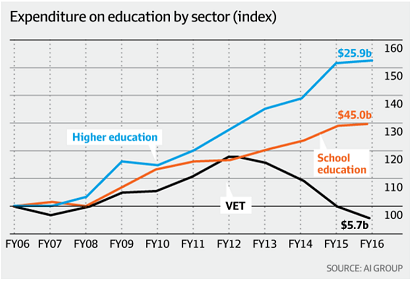
AI Group chief executive Innes Willox indicated that funding for qualifications heavily favours universities. He says that the vocational educational training funding has “fallen off a cliff”.
AI Group reported that spending on universities ‘went from $17 billion in 2006 to $25.9 billion in 2016’, whereas spending on vocational training has been reduced from ‘$5.9 billion to $5.7 billion’. Willox has previously said:
“It’s a case of different but unequal. There is a perception that the training sector is ‘lower’ than the university system because of the status of the jobs the sector serves. If the Australian economy is to prosper and remain internationally competitive, it is vital to have access to a highly skilled and qualified workforce. With the rapid advance of technology and digitalisation, a higher level of skills for the workforce is more important than ever.”
And despite the funding inequity he told media:
“The higher education system is not fit for purpose. There’s a real concern among employers that we’re reaching a crisis point in having an available stock of students with knowledge they need.”
The lack of funding seems to be related to the declining perception of the sector and has resulted in what the AI Group feels are low numbers: 1.6 million vocational training students in Australia.
The Australian Industry Group also put out their CEO Business Prospects Survey. They surveyed national CEOs, finding that optimism was hard to find for 2019.
The 2019 Australian federal election is coming up and the hope is that the incoming government will prioritize what is best for education and training institutions across Australia. The AI Group says that the tertiary education system ‘requires comprehensive policy overhaul’. Willox concludes:
“The VET sector is in need of immediate attention in this area. In this context, demand-driven funding models need to be retained but improved to be more equitable than existing practice.”
Furthermore, the report clamours for workplace learning to be recognized as a component of tertiary education in future. Universities are filling their classes with students, and teaching the appropriate amount of theory, but once graduates are produced, their workplace skills and ability is highly questionable. AI Group says the qualifications’ structure in Australia ‘needs to be reviewed’ in order to welcome micro-degrees and the kinds of vocational training courses that teach skills.
Works Cited
“'Seriously Unbalanced': AiGroup Slams University Bias in Training.” Financial Review, Financial Review, 31 Jan. 2019, www.afr.com/news/policy/education/seriously-unbalanced-aigroup-slams-university-bias-in-training-20190131-h1aofz.
“Media Releases.” Australian Industry Group, www.aigroup.com.au/policy-and-research/mediacentre/releases/.
In 2002, Fortunate Nyamidembo began pursuing a career in the engineering industry. By 2005, he had graduated with a National Certificate in Electrical Power Engineering and acquired a Trade Test Certificate.
He also obtained a Certificate of Compliance to become a Wireman License holder. Recently, he graduated with an Advanced Diploma of Applied Electrical Engineering through the Engineering Institute of Technology (EIT).
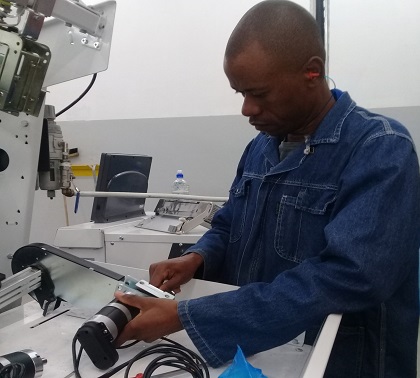
He has recently experienced a period of transition within his career: he has departed the textiles industry and moved onto engineering design and manufacturing in Road Tanker Manufacturing. Reflecting on his varied career thus far, he said:
“In my 13 year career, I have enjoyed the test of engineering in vast areas and got opportunities to collaborate with local and overseas technicians and engineers to tackle the job tasks. I worked for various sectors from textiles, manufacturing, steel processing, installation projects and even designing. Things I got involved with range from power, pneumatics, hydraulics, automation, electronics and instruments.”
Fortunate said he has been fascinated by watching industrial automation and processing creep into the engineering industry at almost every level. His everyday responsibilities include plant maintenance; responding to breakdowns, team leading, project designing, and upgrades.
He says EIT’s online training methods have enhanced his career and made him more confident in his ability to solve engineering problems in the workplace.
While working and studying simultaneously is a challenge, Fortunate said he was prepared to tackle it.
“I had to draw up a timetable that I forced myself to adhere to and cut unnecessary activities like watching television. Any TV I did watch was mainly engineering programmes like ‘Mega-Factories’ and ‘How it’s Made’.”
In his spare time, he conducts his own engineering experiments. He also plans to continue upskilling and acquiring qualifications — he wants to pursue either a Bachelor of Science (Industrial Automation Engineering) or a Bachelor of Science (Electrical Engineering) with EIT. Above all, Fortunate says he aims to continue implementing the knowledge and training he is gaining through his studies in his daily, hands-on job.
Oyama Khanyisile Vundla is a 24-year old young woman from a township named Madadeni in KwaZulu-Natal province in South Africa. She recently graduated from the Engineering Institute of Technology, acquiring an Advanced Diploma of Civil and Structural Engineering.
A middle child, Oyama has two brothers, but was raised by her grandmother after her mother died. She says that her grandmother was dubious about her wanting to become an engineer.
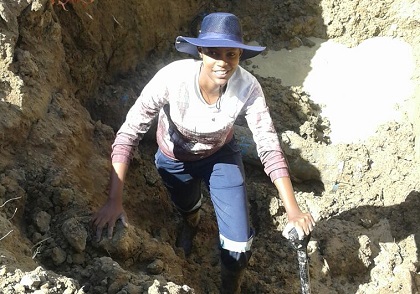
“She had her doubts that I would make it in an industry so dominated by men. Because of that, I had to work had and prove her wrong,” Oyama said.
Oyama graduated from high school in 2012, immediately enrolling in Civil Engineering studies at South West Gauteng College - a technical and vocational training college.
“I have always had an interest in construction work, wanting to know how the buildings and structures are erected and assembled,” she said.
In the trenches
In 2015, whilst doing her N6 certificate, she got a call from Rand Water, offering her a Plumbing apprenticeship that would last three years. She jumped at the opportunity immediately after obtaining her N6. She found herself at the Newcastle Training Center doing theoretical training for Plumbing, but did not manage to get the 18 months work experience so did not graduate from the college.
In 2016, she did some digging and found the Engineering Institute of Technology. That wasn’t the only digging she did: she also managed to track down her estranged father and expressed her desires to become an Engineer. He promised to help out with the fees for her studies, impressed that she was pursuing something as technical as engineering. She began studying through EIT whilst completing her apprenticeship. She was off to the races.
“I started the course using my phone to attend and would go to the internet cafe for the writing and submission of my assignments,” she recalls.
Obstacles on the road to success
Soon after she began the course her father was retrenched and could not continue to pay her fees. This inevitably caused Oyama stress and her first thoughts were that she would have to pull out of the course. She began falling behind on the course work and her assignments. But her tenacity got the better of her; she was not to be beaten. She renewed her commitment to the course, and at the same time, began applying for bursaries.
The Department of Military Veterans in South Africa responded and awarded her with a bursary. Despite these good tidings she realised that she risked having to pay the bursary money back to Military Veterans if she failed her advanced diploma. With the added pressure of being a woman in a male-dominated industry, and with her grandmother’s doubts, Oyama had to rise to the occasion and pass against all odds.
“Nobody believed in me, it was very hard to fight this on my own because even the colleagues I worked with during the apprenticeship would ask how on earth I was going to make it in this men’s industry. I told them to ‘watch and learn’,” she feistily asserted.
A Star is Born
On the 18th of October 2018, Oyama attended the EIT Graduation Gala and received her Advanced Diploma in Civil and Structural Engineering. As her name was called, she triumphantly walked towards the stage, knowing she had achieved what seemed like the impossible. Oyama said she chalks all the success she’s had in her life up to the grace of God.
“I am preaching the words to other females out there, telling them that there is no boundary for us women - we can also make it no matter what. Have a will, have a desire, know what you want and stick to it and in so doing, nothing can stand in your way,” she concluded.
“As long as women know what they want and have got what it takes to stand up to all the pressure, there is absolutely nothing stopping us. Women can dominate in this industry as long as they are interested and eager. It is high time we change our states of mind and give it the best shot we have.”
David Beeson is a former metallurgical engineer who discovered a passion for process control, despite his initial misgivings when still an undergraduate student; he found it a difficult and confusing subject at university. Now he has a blossoming career in the field and ensures he stays abreast of changes in the industry by pursuing professional development.
In fact David has recently graduated from the Engineering Institute of Technology, with a Master of Engineering in Industrial Automation - big-time professional development!
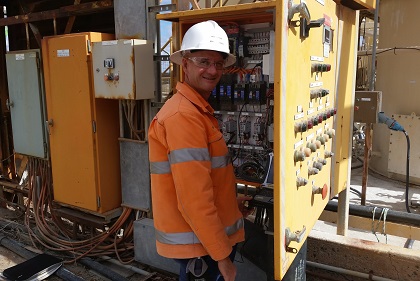
He provides a brief insight into the work he does:
"I am currently working as a process control engineer at a small but capable company that provides process control solution design, installation and commissioning services to the mineral processing industry."
David became familiar with furnaces and the molten metal as a metallurgical engineer, but is now more at home in freezing cold server rooms! Regardless, David observes that automation is the rising star across all engineering industries. This was his stimulus to pursue his Masters in Engineering (Industrial Automation), but the prospect of the thesis was daunting. He said:
"The thesis was both a highlight and a challenge. The highlight was having the opportunity to explore and understand what is actually involved in setting up an advanced control strategy, and the challenge was the research process – venturing into the unknown with an uncertain outcome and a lot to do in a short time period."
He went on to comment about an early hurdle during the degree:
"Another challenge was one of the first subjects – Power Engineering. With no electrical background I got lost in the sine and cosine functions a few times, but overall it was a great subject – all about controlling something that you cannot see."
Now that David is a graduate, he is reflecting on the skills that he learned throughout his studies. He recently guided an electrician through the fault finding process when connecting cables between a drive and a PLC; he was very pleasantly surprised with how much he knew and how much he could help. He explains that he has gained amazing awareness of the technologies and processes of the automation world and now is more confidently working in the industry.
He also surprises himself. As time goes on, he stumbles onto challenges that he finds himself capable of solving, thanks to the practical skill building the master’s qualification equipped him with.
EIT + family = happiness
Doing his Masters of Industrial Automation also helped David become a ‘cooler dad’! He fondly reflects:
"More recently my daughter was doing binary as part of her digital technology subject in year 7. She started talking about ASCII and I thought, ‘I actually know what that is’, and was able to answer her many questions on the subject."
David is a husband and a father to two, and outside of work he loves stand-up paddle-boarding, woodwork and Brazilian Jiu-Jitsu. Congratulations to David – not only has he graduated from a challenging master’s degree, but was nominated a runner up for the 2018 Graduate of the Year.
Dear Colleagues
It is always hard to know genuinely how well or badly you are doing in your job when you try and get honest opinions from those around you. Especially if you are leading a team. The last thing on their mind is for a team member to give you an honest appraisal of how you are doing. In case it damages their position or irritates you. Thus you will often hear that you are tracking extraordinarily well and are the epitomy of success. Often this is very far from the truth.
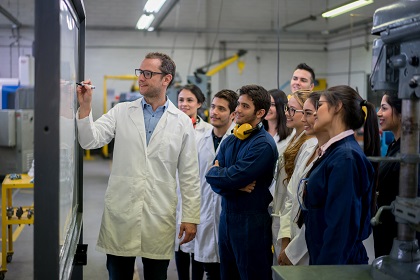
Thus a few strategies are sketched out below to get some good hard honest feedback on how you are performing. Often extraordinarily painful but ….one can’t hide from the brutal truth. And once you have key information about deficiencies (and indeed, great things you do or have done); you can work on improving on these problems. Actionable solid feedback should be regular to show you how you are developing (either badly or well).
Jennifer Porter quotes from research which indicates that you need three elements to boost your performance:
- Clear objectives
- Feedback on how you are shaping up – both good and bad points
- A real ability and drive to achieve these goals (often the biggest challenge of all)
A few points on getting great feedback:
Maintain a Professional and Safe Environment for Everyone
Ensure that good quality feedback (not gossip or malicious back stabbing) can be passed on without fear or favour. As someone who is receiving the feedback – listen carefully and don’t interrupt when people are giving you the data.
Educate people in how to pass on feedback
Feedback should be useful and actionable. Not flim-flam, anecdotal and irrelevant fluff. Your team can be coached in how to pass on helpful feedback and to pass on hard truths in a professional clinical manner to benefit you and improve the performance of the team. Ask specific questions which come up with useful information:’Do I listen enough to what people say?’;’Do I encourage young engineers in their work?’;’Do I criticize others very negatively with no encouraging words?’.
Ensure that you get both positive and negative feedback
It is unlikely that you will only have positive or negative feedback issues. Mostly, it will be a mix of both attributes. Some managers brutally say when requesting feedback: ‘Give it to me with both barrels – all the worse attributes.’ However, often there are some hugely positive personality traits that should be mentioned as well.
Focus on the trait or attribute rather than the person
Deal with the issue rather than the person when listening to someone list what they believe needs to be improved. This will help you deal with the irritation or anger that may well up in you when you believe you have received unfair criticism. Even if supremely upset by the feedback, ensure you let the person know that you are grateful for her honesty.
Reflect on the feedback, deal with it and maintain the improvements
It is now vital to consider the feedback and work out ways to fix the problems. Sometimes the feedback isn’t fair; but generally there is always an ounce of truth in the commentary – thus requiring action. Write down what the feedback was and ensure you remind yourself every day what you have done to fix it. Confirm with yourself on a daily basis that you have changed and then after a few months, review it with the person who made the original comment and check.
Remember it is always painfully hard to make adjustments to one’s habits and personality traits. However, in acting on fair commentary you will be an improved team member or leader. This process of identifying flaws and fixing them is a key element of being a leader.
Thanks to Jennifer Porter of the Harvard Business Review for some thoughtful commentary.
Ken Blanchard makes the point: Feedback is the breakfast of champions.
Yours in engineering learning
Steve
The week of the 14th of January 2019 was an eventful week in Zimbabwe. Weekend protests against the doubling of the fuel price in Zimbabwe spilled over into the Monday - and the government was ready to retaliate.
Citizens woke to an SMS alert from their biggest mobile operator, EWZ:
“Further to a warrant issued by the Minister of State in the President’s Office for the National Security through the Director General of the President’s Dept, acting in terms of the Interception of Communications Act, internet services are currently suspended across all networks and internet service providers. We are obliged to act when directed to do so and the matter is beyond our control. All inconveniences are sincerely regretted.”

A crackdown on all anti-government protests was in full swing and the Zimbabwean government did not want the world seeing what that crackdown entailed. The internet was subsequently shut off for all Zimbabwean citizens. Not even a Virtual Private Network - which some Zimbabwean citizens utilize - could be used to access the internet.
On the 21st of January the Zimbabwean High Court ruled that the government had no authority to shut down the country’s internet.
Zimbabwe recently saw Emmerson Mnangagwa sworn into the presidency - after former president, Robert Mugabe, was ousted in a coup. The incumbent seems to be struggling to steer the country out of an economic slump and is struggling to win the hearts of the citizens.
George Charamba, the spokesman for President Emmerson Mnangagwa told the country’s Sunday News: “The response so far is just a foretaste of things to come. The MDC (opposition party) and its affiliate organisations will be held fully accountable for the violence and the looting.”
Many are concerned that the government of Zimbabwe is slipping deeper into authoritarianism and fear that the situation in the country might not improve.
The effect of a shutdown
The Engineering Institute of Technology relies on functioning internet connections to deliver its live online engineering training and education across borders around the globe. EIT has a presence in Zimbabwe – we have students and staff in the country.
In the aftermath of the internet shutdown, Isabel Sibanda, a learning support officer working remotely for EIT in Zimbabwe, said:
“No internet for a global learning support officer means that I cannot work at all. I cannot respond to queries timeously. On one of the days following the shutdown we got our internet back at around nine in the evening; I was forced to catch up on work until just after midnight. Personally, I could not communicate with my family. I was not able to contact any of my siblings outside of Zimbabwe outside of Zimbabwe on Whatsapp. It was a bit scary.”
Thankfully the Zimbabwean High Court ruling will prevent the government from future shutdowns. Despite the ruling and despite the hope that the people put into their new President, it appears that it is becoming increasingly difficult to turn the economy around.
In the face of these latest upheavals EIT students in Zimbabwe continue to assist each other to overcome the hurdles. In 2018, Algate Panyika Mtemah received an Honorary Student Award; he very kindly assisted students transfer money when these services were unavailable. He ensured a number of students in Zimbabwe could continue studying.
Amidst difficult political climates, wherever they may manifest in our partner countries, EIT will continue to strive to find innovative solutions for education and training globally. And we commend our students and learning support officers for doing so as well.
Works Cited
“Zim High Court Rules Internet Shutdown Illegal, Orders Govt to Restore Full Internet to the Country.” News24, 21 Jan. 2019, www.news24.com/Africa/Zimbabwe/just-in-zim-high-court-rules-internet-shutdown-illegal-orders-govt-to-restore-full-internet-to-the-country-20190121.
We are proud to announce our 2019 Student Ambassador is Tatenda Nherera. He is a member of EIT’s alumni community and will now be representing our current and prospective students.
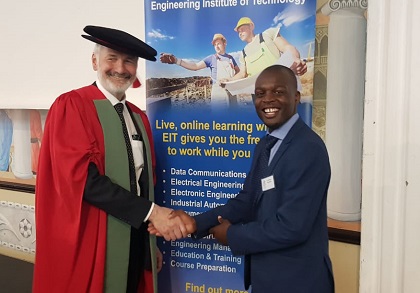
Tatenda recently graduated from EIT’s 52684WA – Advanced Diploma of Electrical and Instrumentation (E&I) Engineering for Oil and Gas Facilities. He said EIT’s online delivery mode allowed him to continue working full-time, while improving his instrumentation knowledge and technical writing skills. This newfound expertise helped him in his work with the Eastern Cape Department of Health and Department of Public Works; his main responsibilities include servicing, maintenance and repair of their key and sophisticated steam boilers, laundry and kitchen machines for many Health Facility and Correctional Service Centres in the South African province.
Tatenda began studying engineering in 2008, when he enrolled in the Gweru Polytechnic College in Zimbabwe as an electrical power student. He then began studying with EIT in 2015 — now he’s completing his Bachelor of Science (Industrial Automation Engineering) with us.
“I will remain employed and still study part time as I did on my previous course. The studies are giving me more meaningful skills, and contributing to the African society, where engineering skills like mine are very scarce,” he said.
You can view Tatenda’s professional LinkedIn profile here: https://www.linkedin.com/in/tatenda-nherera-40440a61/?originalSubdomain=za
If you would like to find out more about his experience studying with EIT, please email
Hi everyone,
A few weeks back we sent an email out to our students regarding their overall experiences with the Remote Labs. The feedback we received was extremely comprehensive; allowing us to identify and mitigate the primary points of confusions.
To subsequently amend this, we are rolling out a new version of the Remote Labs. The new version consists primarily of minor tweaks and fixes, but we have a few major updates listed below that you might like.
The new version will be rolled out over the next few days, so your experience with the labs may be slightly intermittent.
Connection Quality Indicator
A common setback of our institute's global reach is the inadequate connection speeds some of our students incur. Our development team has implemented a connection quality indicator will now appear next to the Timetable of labs in real-time. While TeamViewer generally provides a highly optimised experience when connecting to the labs, the connection indicator will provide some insight into how your session with the labs will be.
The various indicators consist of a green circle, yellow circle, and red circle (green being the best connection, and red being the worst). While it is a simplistic indicator, they do provide a relatively accurate understanding of your connection experience will be when connecting to the labs.

If you need to use a particular software, you can now pre-empt your lab experience by booking a lab with a better quality indicator.
Simplified and Secure Connection Experience
Another major improvement consists of the process from the Remote Lab platform to TeamViewer. You can now simply just click on the commence lab button, and the TeamViewer program will appear with the password.

Improvements with the security of the labs have also been made. Instead of a universal default password, you will have a unique password generated for your session. You need to copy that into the TeamViewer password popup to commence your session.
The below video will display the process:
The purpose of this is to ensure that another person can't accidentally enter the lab when it is not their time.
If you have any questions regarding this upgrade, please feel free to contact us via our Lab contact form, or contact your LSO.
Mechanical engineers are ready to unveil the mechanical clean energy technology that has been 10 years in the making.
The engineering firm behind it is named Makani, a company tied to Alphabet’s Google X Lab. The purpose of the company is to ‘create radical new technologies to solve some of the world’s hardest problems’.
One of the more renowned projects that have come from Google X Lab is Project Loon; specially engineered balloons that could be launched into the stratosphere and provide internet access to rural parts of the world.
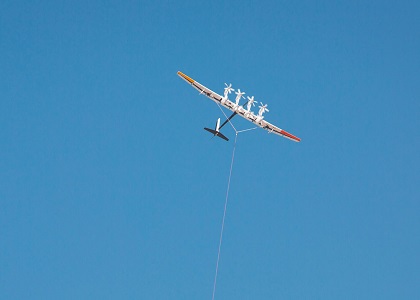
Makani, is joining their fellow projects with airborne technologies that could help people on the ground a whole lot. You may have heard of wind energy, but have you heard of airborne wind energy?
What they have developed are called ‘Makani kites’. Makani energy kites, the company says, will produce electricity by harnessing energy efficiently from the wind.
The ‘kite’ is a solar-plane looking object with four rotors that gets flung through the air and gets thrown into a loop. Whilst in the loop, the rotors spin and the wind moves through them. The kite flies autonomously 1400 feet high and loops in a diameter of 250 meters. The rotors’ energy, moving with the force of the wind, generates the electricity. On-board the kite, sensors, a GPS and inertial navigation system are all present.
The company on their website say:
“Wind energy has the potential to power the world 100 times over, yet only 4% of the world’s electricity comes from wind. The Makani energy kite system integrates advances in aerospace engineering, materials science, and autonomous controls to create a lightweight design that is easy to transport and install.”
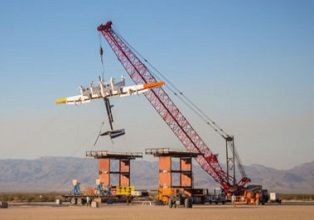
They also note that only 4% of the world’s electricity comes from wind. Thus, they intend to use the kites to up the amount of electricity that can be distributed via the kite-generation method to up the aforementioned percentage.
The kite’s energy generating capacity is in its name: M600. The kite will generate 600 kW of electricity - roughly the amount of energy that could power 300 homes.
And the applications for the technology keep growing. The engineers are confident that their kite could be useful in areas that have been devastated by natural disasters who have lost access to electricity.
“The low mass of Makani’s system unlocks wind energy resources in areas like deepwater offshore that are not economically viable for existing technologies. Harnessing energy from the wind in new place means more people around the world will have access to clean, affordable wind power.”
According to Teslarati, the industry is starting to heat up and competitors are entering the fray in the airborne wind energy industry. However, Makani is the only company generating electricity in the way they are.
The engineers are not finished innovating. They are at work, designing more technologically advanced versions of the kite. The future of agile wind energy could be big - which makes it a good industry for mechanical engineers and electrical engineers to monitor.
Works Cited
Alvarez, Simon. “TSLA Analyst Summarizes Model 3 Ramp: ‘Tesla Failed on Its Original Plan, but Achieved a World-Class Result.’” TESLARATI.com, TESLARATI.com, 6 Dec. 2018, www.teslarati.com/tesla-tsla-analyst-model-3-ramp-original-plan-fail-world-class-result/.
“Makani Kites: Airborne Wind Energy.” X – The Moonshot Factory, x.company/makani/.
As 2019 begins another year of engineering innovation lies ahead.
This year’s engineering buzzword is: REVOLUTION. The cutting edge technologies that have begun to change the way engineers are educated and the way they perform their tasks in the workplace will only increase.
The Engineer, a UK based engineering magazine, has outlined what technologies will see ongoing development in 2019:
- Electric-powered mobility
- Additive manufacturing
- Virtual and augmented reality
- Artificial intelligence: smartphones, smart factories, etc

They suggest that the Fourth Industrial Revolution will impact all industries and all levels of society and reach mainstream status in 2019. This makes it critical for people across the board – but particularly in industries underpinned by these technologies – to become familiar with them, to ensure they can contribute ably in their places of work.
Most importantly, they warn that the engineering sector should address the skills shortages that may well become prevalent with the disruptive nature of these technologies.
The UK based magazine is inevitably reflecting on the lingering uncertainty of Brexit. If all goes smoothly it should be a done deal by the 29th of March 2019. They write:
“Despite this, the pace of technological change in the UK has continued largely unabated. And while most engineering and manufacturing businesses we’ve spoken to over the course of the past couple of years would happily turn the clock back to those uncomplicated pre-referendum days, there’s a growing sense that technology - in particular processes and techniques that can help boost manufacturing productivity - will play a key role in helping the UK adjust to the outcome of Brexit.”
The global shifts in government - prompted by elections – also impacts engineering. But aside from government policy changes and the impact of the Fourth Industrial Revolution, technical skills remain vital. They are needed for the maintenance of already existing technologies (and indeed those still emerging).
Training and education providers will need to ensure they are prepared to service this changing workforce. It is likely that micro-degrees and micro-credential will gain further attention and traction in 2019, as people seek to update skills and knowledge.
Computers, robots, coding
Luke Dormehl, a technology commentator and author, speaking to the team at the Engineering & Technology website said:
“AI and its related hardware-centric field of robotics will continue transforming the workplace in 2019. Whatever profession you work in, whether it’s medicine, law, driving a taxi or working in a warehouse, you can expect to see a growing level of disruption from the steely hand of automation.”
He comments on one of the World Economic Forum’s predictions: 75 million jobs will be replaced by automation in 2025; the good news is that 133 million jobs will be created. He says:
“Many new jobs will involve computer skills. For instance, machine learners and coders will be poised to reap the rewards. However, not every new type of job will involve being the next Mark Zuckerberg.”
Examples abound: if you are based in India, for instance, it may be worth viewing your career through an Uber-lens - an Uber-digital lens: Uber in India will be doubling its engineering workforce - from 500 technologists to 1,000. They will also be sourcing product designers, data scientists, user researchers, front-end and back-end engineers, plus machine learning and artificial intelligence professionals.
For prospective engineers this New Year: stay in the loop, constantly upskill and work hard! And one more thing: keep your eye on those companies which were established in the last decade and are on the cutting edge of engineering endeavor - they are hiring dozens of engineering personnel.
Works Cited
Pozniak, Helena. “Technologies to Watch in 2019: Predictions for the Engineering Year Ahead.” RSS, 7 Dec. 2018, eandt.theiet.org/content/articles/2018/12/technologies-to-watch-in-2019-predictions-for-the-engineering-year-ahead/.
“Tech Trends 2019 - the Engineering Year Ahead.” The Engineer, 5 Dec. 2018, www.theengineer.co.uk/tech-trends-2019/.
“Uber India to Double down on Hiring Engineers in 2019.” The Economic Times, Economic Times, 8 Dec. 2018, economictimes.indiatimes.com/jobs/uber-india-to-double-down-on-hiring-engineers-in-2019/articleshow/66998276.cms.
An earthquake rocked the city of Anchorage in the state of Alaska on Friday the 30th of November 2018. On the Richter scale, it measured in at 7.0. Since then 1,000 aftershocks have been observed. Not since 1964 had there been such an intense earthquake in the area.
Thankfully, there were no deaths or serious injuries reported in the aftermath of the quake. However, infrastructure was hit incredibly hard. Roadways in Anchorage were damaged, and water lines were ruptured. Natural gas workers have also been flown in to restore gas to households, and fix any faults that might have occurred when the earthquake hit.
The civil engineers jumped into action, repairing the roads in record time! The repair crews have become the golden standard for civil engineering reaction to post-earthquake road repair.
One of the more damaged roads was the freeway off-ramp at the International Airport Road and Minnesota Boulevard. The road was featured in much of the mainstream media coverage of the earthquake and shows what the repair crews faced.

Despite this it took only four days for the Alaska Department of Transportation and Public Facilities to complete the repairs!
Alaska Tour & Travel’s Facebook page shared the image of the seemingly overnight repair. Even the Anchorage Police Department shared the image. The write up read:
“Here is just another great example how Alaskans are responding after last Friday’s earthquake! The off-ramp at International Airport Road and Minnesota Boulevard in Anchorage was reopened early this morning, complete with new asphalt.”
So astounding was the turn-around that social media commenters dismissed the photo as fake. One commenter joked that it would take six years to fix a pothole in Texas. An Alaskan commenter eventually uploaded his own photo of the newly repaired road, proving that the road had indeed been repaired. Other commenters celebrated the repair crews who braved the cold and patched the road up.
The Department of Transportation reported that compacting asphalt in the colder temperatures was difficult, but the repairs had to be done.
The Anchorage Assembly declared a state of civil emergency in the city as earthquake damage repairs progressed. The structural integrity of the bridges, after the quake, was also a major concern. Extra inspectors were brought in from the Department of Transportation to do the necessary studies and calculate the damage. Aftershocks were the most concerning, because further cracks to bridges and roads could be expected.
Overall, the remarkably efficient repairs to the roads and other infrastructure in Anchorage are astounding - the only other example of roads being repaired so quickly after earthquake damage is in Japan.
Works Cited
Gilmour, Jared. “Alaska Road Crews Quickly Fix Quake Damage, Shocking Pothole-Plagued Lower 48.” Thenewstribune, The News Tribune, www.thenewstribune.com/news/nation-world/national/article222638685.html.
Holcombe, Madeline, and Eliott C. McLaughlin. “Alaska Hit by More than 230 Small Earthquakes since Friday.” CNN, Cable News Network, 2 Dec. 2018, edition.cnn.com/2018/12/02/us/alaska-earthquake/index.html.
A substantive reduction in the global workforce - due to automation - is expected to occur in the next 3 years. However, according to a report by the World Economic Forum (WEF), some businesses are more excited than anxious.
The WEF report states that 38% of businesses are positive about the future of jobs; they ‘expect to extend their workforce to new productivity-enhancing roles’. Inevitably the new roles will entail new tasks, so to avoid skills shortages companies and educators need to make this a priority:
“By 2022, no less than 54% of all employees will require significant re- and upskilling. Of these, about 35% are expected to require additional training of up to six months, 9% will require reskilling lasting six to 12 months, while 10% will require additional skills training of more than a year.”
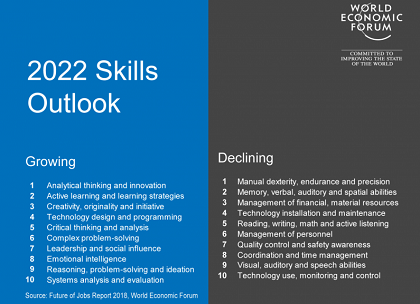
Upon that reskilling and upskilling, the WEF says that there will be a ‘net positive outlook for jobs’.
Understandably, though, many people are baffled: which skills should be nurtured and honed and which ones discarded? The following table created by the WEF goes some way to clarifying this, although I believe in many respects it’s a ‘wait and see’ situation.
How did we get here?
The future of work has been growing legs thanks to several drivers of change. The name we have given collectively to these drivers of change is: The Fourth Industrial Revolution. It was in the previous three industrial revolutions where work and domain expertise became more pronounced in society.
The Fourth Industrial Revolution is doing away with work as we know it and domain expertise as we know it. The drivers of change specifically referenced to in the WEF report are:
- High-speed mobile internet
- Artificial intelligence
- Big data analytics
- Cloud technology
These inventions are causing immense change and disruption in most, if not all industries. But disruption is not entirely bad experts are asserting. Disruption in the education space, for instance, is something that could democratize education with more people able to access it.
What can you do?
The WEF reckons that we need to be aware of the rapid development of technology, but particularly with regards to its impact on our jobs. The report suggests that upskilling to meet these shifting job requirements, throughout a career, is best practice for workers in the modern age.
The WEF says that workplaces are going to undergo accelerated technology adoption, but that there will be positive spin-offs: it will relieve workers from some dangerously physical work and will allow us to dodge the more repetitive and dull tasks. Furthermore, the report stated:
“Our findings indicate that by 2022, augmentation of existing jobs through technology may free up workers from the majority of data processing and information search tasks--and may also increasingly support them in high-value tasks such as reasoning and decision-making as augmentation becomes increasingly common over the coming years as a way to supplement and complement human labor.”
Works Cited
“The Future of Jobs Report 2018.” World Economic Forum, www.weforum.org/reports/the-future-of-jobs-report-2018.
McLeod Boipuso Sibanda is a dedicated scholar and works hard in the worlds of geology and engineering.
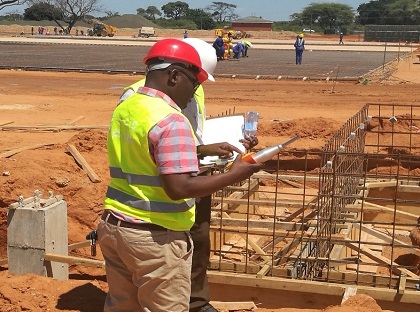
He is a husband, a father of three children, and the Managing Director of a reputable civil engineering company in Botswana.
He was born in the village of Pandamatenga, Botswana, and as a youth he realized he had the knack for engineering.
“From a young age I was passionate about Mathematics and Physics and the civil engineering industry suited my passion for application,” he said.
He holds certificates in Rock Identification and Geotechnical Core logging, Soil Profiling and Chip Logging from the South African Institute for Engineering & Environmental Geologists. He also has a Laboratory and Field Techniques certificate from the University of Cape Town, and he recently graduated with an Advanced Diploma in Civil & Structural Engineering from the Engineering Institute of Technology. He is putting those qualifications to good use. He says:
“I have over 21 years of progressive experience in Civil Engineering, working in the fields of soil mechanics, geotech, laboratory testing and rock mechanics. I will apply what I learned to sharpen my technical writing of geotechnical reports, analyzing all standards of building specifications, boosting my confidence in structural engineering. Most importantly, to share my knowledge and expertise with others.”
He is a hands-on aspirant engineer who works on the development of infrastructure - roads, bridges and tunnels. He is also involved with water and sewer reticulation design, foundation engineering and project management.
McLeod notes that one of the highlights of his career was working on the Kazungula Bridge and Border — a construction that provided a link between Botswana, Zambia, Namibia and Zimbabwe.
McLeod is currently pursuing his Bachelor of Science in Civil and Structural Engineering through EIT. Thereafter he plans to obtain his Masters in Geological Engineering. He believes these qualifications will take his company to greater heights. He concludes:
“Hard work, dedication, success and the desire to achieve whatever goal I set motivates me to keep dreaming.”
Despite being in the midst of his continued professional development, McLeod wrote a book. It is an autobiography which details his childhood and upbringing. It is called: Triumph Awakens In The Midst Of Turbulence.
Engineers often borrow from the natural world and biological processes for their work. But there was one natural process engineers could not fathom, or rather failed to take the time to figure out. Why, or how it is that a wombat’s faecal matter is cube-shaped.
The process of copying some of nature’s principles and using them as inspiration for engineering design is called ‘biomimicry’. But how the study of wombat stools could contribute to the engineering industry has not, up until now, been asked.

Patricia Yang, a mechanical engineer, specializes in hydrodynamics in animal bodies at the Georgia Institute of Technology. She spoke to the Institution of Mechanical Engineers:
“The first thing that drove me to this is that I have never seen anything this weird in biology. That was a mystery. I didn’t even believe it was true at the beginning. I Googled it and saw a lot about the cube-shaped wombat poop, but I was skeptical.”
Yang and her team embarked on a process of studying wombat’s digestive tracts. What they found was that wombats’ intestinal walls caused the formation of cube-like faeces. They are, as far as humans know, the only animal to produce cube-structured faeces.
The thinking is that engineers could design something that mimics the digestive tract and intestinal makeup of the marsupial wombat to help mould cubic structures.
“We currently have only two methods to manufacture cubes: we mould it, or we cut it. Now we have this third method. It would be a cool method to apply to the manufacturing process - how to make a cube with soft tissue instead of just moulding it.”
Whilst Yang and her team are based in the United States, this discovery is quintessentially Australian. The wombat is found in the forest-covered area of southeastern Australia. Yang explained that the intestines are responsible. Apparently the wombat faeces are in a liquid state early on in the intestine, but become firm and cube-shaped in the final 8% of the intestinal tract. She said:
“Wombat intestines have periodic stiffness, meaning stiff-soft-stiff-soft, along the circumference to form cubical faeces.”
Biological Transformation
Europe’s largest application-oriented research organization, Fraunhofer-Gesellschaft is encouraging biomimicry with a new campaign entitled: Futuras In Res. They say that innovators should keep using nature as inspiration when they design new products. They make specific mention of salt shakers - modeled after poppies, robot gripper arms - reminiscent of elephant trunks or cameras - like insect eyes. President of the Fraunhofer-Gesellschaft, Professor Reimund Neugebauer says:

“We regard Biological Transformation as the systematic application and combination of processes, principles and materials found in nature to engineering. It will lead to entirely new and more sustainable processes in value creation and manufacturing. By focusing on nature as a driver of innovations, we can use in a new era.”
Biological Transformation and biomimicry is becoming a hallmark of the Industrie 4.0/fourth industrial revolution. The group brought many industries together in June of this year to collaborate and brainstorm on future technologies that could benefit the world.
The main topics discussed were Industrie 4.0, bio-manufacturing, artificial intelligence, biotechnology, bionics, the circular economy and sustainability.
Engineers should look out for opportunities in these cutting edge industries which are innovating and changing the world. But they should also remain alert - sometimes the breakthrough can be something quite surprising and no more sophisticated than the humble wombat poop!
Works Cited
Mechanical Engineering History Timeline - IMechE, www.imeche.org/news/news-article/engineer-solves-mystery-of-cubic-wombat-faeces-to-inform-manufacturing-processes.
“Biological Transformation: Nature as a Driver of Innovations in Engineering and Manufacturing.” Fraunhofer-Gesellschaft, www.fraunhofer.de/en/press/research-news/2018/june/Biological-Transformation-nature-as-a-driver-of-innovations-in-engineering-and-manufacturing.html.
Another Black Friday and a Cyber Monday have come and gone, as has Christmas and Boxing Day.
According to VOX, it is estimated that the US Postal Service makes 850 million deliveries from Thanksgiving to New Year’s Day. That equates to a lot of parcel deliveries via a host of transportation technologies.
Executive Director at The Energy Policy Institute at the University of Chicago pointed out back in 2016 that US C02 emissions from transport eclipsed power stations for the first time since 1979.
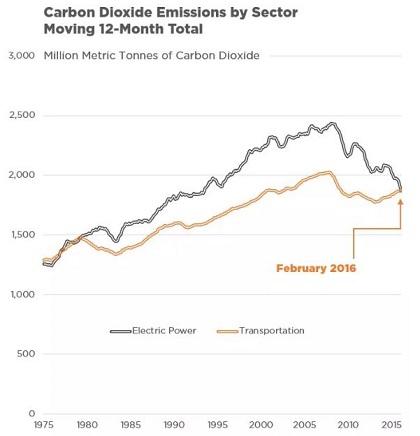
Air quality is becoming a bone of contention for many people around the world, but do they know exactly which entities are the worst offenders for polluting the air?
Not until now – and it is thanks to engineering.
Sensor and satellite technologies are producing data which will help inform citizens and make private sector and government far more transparent.
An organization named Resources for the Future, use satellite data to measure air pollution. Their conclusions, as compared with previous studies, indicate that 24% more Americans live in areas that do not meet the federal air quality standards, as set out by the Environment Protection Agency.
The 24% spike is concerning, but the use of multiple sensors may account for the increase.
New technologies = more data
Engineered sensor technologies are becoming increasingly important to climate scientists and energy policy makers alike. Historically, air quality monitors have been overly expensive. This has led to single investments of air quality monitors in US states, and the statistics, therefore, are relevant only to focused pockets rather than to the length and breadth of each state. Some states literally have one stationary sensor measuring air quality.
The Environmental Defense Fund demonstrates the illogical nature of single monitors versus the clearly superior mobile sensors:

Google Earth Outreach has come to the rescue, piloting a project that will see low-cost sensors map air pollution at a ‘hyperlocal’ level. The EDF says these sensors can ‘be mounted on cars, trucks, and even bicycles - or in denser stationary networks than regulatory monitors’.
With the wider network of sensors capturing air quality data, a clearer picture of the degradation of air quality can be made. Furthermore, the mobile sensors will enable everyone to access the information via online maps with updated air quality readings.
Making the data freely available could have interesting consequences.In the near future, for example, before people make a property investment, the air quality of the area may be considered first and foremost.
Forbes is encouraging companies to equip themselves with the kind of processes which might spare them the public scorn of their carbon footprint. Especially the kinds of companies involved in the shipping and logistics industries. They suggest companies do the following to prevent future outrage when mobile sensors give the public a clearer picture of the air quality around their buildings:
- Do an energy audit, invest in energy efficiency, and electrify building heat sources.
- Invest in renewables or purchase energy from clean energy providers.
- Work with your supply chain to set science-based targets, adopt best practices, and measure and report progress.
- Partner with other companies, utilities, communities and governments to innovate, create infrastructure, and show demand for heavy-duty vehicle electrification
Works Cited
Fund, Environmental Defense. “New Technology, Transparency Will Soon Tie Air Pollution Back To Brands.” Forbes, Forbes Magazine, 20 Nov. 2018, www.forbes.com/sites/edfenergyexchange/2018/11/20/new-technology-transparency-will-soon-tie-air-pollution-back-to-brands/#276af29a10b6.
Ori, Sam. “Sam Ori (@samori8).” Twitter, Twitter, 26 Nov. 2018, twitter.com/samori8.
“A New Challenge for Sensors: 24 Million More Americans Breathing Unhealthy Air than Previously Thought.” Environmental Defense Fund, www.edf.org/blog/2018/09/20/new-challenge-sensors-24-million-more-americans-breathing-unhealthy-air-previously.
With the proliferation of renewable energy, industrial automation and electrical engineers are banding together to create the power grids of the future. The latest automated mechanisms making factories more efficient are also making their way into the electricity distribution industry - for smarter power grids.
Future-proof energy grids which use intelligent, automated technologies are being targeted by governments around the world. They are, however, expected to improve on coal-powered electricity generation.
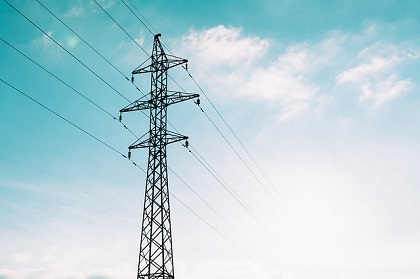
In South Africa, poorly designed power stations have led to rolling blackouts in the country. According to City Press, at one of the more important power stations, Medupi Power Station, design flaws resulted in its failure ‘to control the heat of superheated steam circulating between the boiler and the turbine that produces electricity’.
This is something the Industrial Internet of Things (IIoT) and new cutting edge automation technologies could prevent. With IIoT in the design phase, automation engineers could have avoided these design blunders and rolling blackouts.
Power plants can be run more efficiently - generating more data for engineers to peruse – to ensure there is continuous monitoring of the health of the plant, and much more. Analog will have to give way to digital means of control in the electricity sector.
The IIoT-World’s checklist of functions (or qualities) that a IIoT-connected power plant should embody is an incredibly comprehensive summary of what is expected from the power plant of the future. The plants need to be:
Evolving
- Continuously learns from the past to improve efficiency
- Has a technology foundation that evolves, never becoming obsolete
- Allows continuous and flexible DCS upgrades
Self-sustaining
- Is aware of its operating status, all the time
- Knows its operating limits and capabilities
- Asks for maintenance at the correct time
- Does more with less - in operations and maintenance
Predictive
- Knows how much energy it needs to produce to meet market commitments
- Manages resources optimally in relation to operating status, weather and market constraints
- Know when equipment has developed a fault and when it requires repair
Protecting
- Safe for people, the local community and the environment
- Conscious of its environmental impact, always minimizes emissions
- Safe for employees
- Cyber secure
Adapting
- Flexible in relation to market requests
- Anticipates market requests by forecasting external conditions
- Open and responsive to owner and grid requirements
- Can operate within a virtual power pool of renewable and conventional plants
Introducing industrial automation into the electrical engineering industry will help keep the lights on across the world.
Creating smarter networks of electricity distribution at a utility level is all good and well - but decentralizing it will also be advantageous. In South Africa’s case Eskom has the monopoly on distribution. It has stifled progress and many believe privatization of the industry will provide a solution.
Mark Feasel, vice president of Schneider Electric, talking to Automation World said:
“Being able to accommodate energy created in a more decentralized fashion is the story of a more complex grid. Automation is key to unlocking the ability to operate in this world of more complexity.”
Automation World contributing writer, Beth Stackpole, points out that centralized utilities are not able to keep up with galloping innovation: from the varied and unstable sources of electricity through to the many new uses for it. She writes:
“The legacy grid, based on a central generation, transmission and distribution model, was not architected to support modern-day electricity needs--whether accommodating peak demands for unpredictable renewable energy sources like wind and solar, or driving the burgeoning market for electric vehicles (EVs).”
Increasingly engineers are finding they are obliged to broaden their engineering knowledge, and so it is here: industrial automation has begun to play a substantial role in electricity distribution methodologies. The industrial technologies and their automated functions are being implemented in this multidisciplinary way to ensure that efficiency is upheld across all industries.
Works Cited
“Automating the Grid in a Modern Age of Electrification.” The Wireless Revolution: Transforming Industrial Networking | Automation World, www.automationworld.com/article/topics/industrial-internet-things/automating-grid-modern-age-electrification.
“Five Main Qualities of Industrial IoT in the Digital Power Plants.” Create a Culture of Innovation with IIoT World!, 29 Sept. 2017, iiot-world.com/connected-industry/five-main-qualities-of-industrial-iot-in-the-digital-power-plants/.
Rensburg, Dewald van, and Aldi Schoeman. “Inside the Eskom Crisis: Why the Lights Keep on Going Out.” CityPress, 10 Dec. 2018, city-press.news24.com/News/inside-the-eskom-crisis-why-the-lights-keep-on-going-out-20181210.
Blog - Steve Mackay
EIT's Technical Director, Steve Mackay, enjoys keeping his blog up-to-date with useful tips and current industry matters for his fellow colleagues. He has a loyal and expanding following base reaching over 300,000 people around the world.
Student Stories
In this section you have the opportunity to read and listen to EIT students talking about the reality of the programs. Discussions are wide-ranging and include information about the study commitment required, the value of the qualification in their careers, the relevance of the subject matter, future pathways, and more. They provide valuable feedback for you to take into account before you decide to join one of our programs.
Career Information
Latest career information including industry research, podcasts, blogs, life hacks and general information about how you can make the most out of your career.
Education
Here you will find out more about the latest trends and developments within education worldwide, along with some helpful articles regarding study tips and keeping on track with your studies.
Developments
The latest innovation and inventions from the world of engineering can be found here. Learn about advances in technology and how they can make a real difference within your industry.
Announcements
Keep up to date with the latest announcements from the Engineering Institute of Technology. In this section you can read more about new courses, new recognition from professional bodies, our Excellence in Teaching Award, upcoming free webinars and much more.
Monthly Update
We understand that you may not have time to read all the articles that we post, so our monthly update gives you access to some fascinating articles which cover the best of the months news in a compact format.
